Invega Sustenna: Package Insert / Prescribing Info
Package insert / product label
Generic name: paliperidone palmitate
Dosage form: injection
Drug class: Atypical antipsychotics
J Code (medical billing code): J2426 (1 mg, injection)
Medically reviewed by Drugs.com. Last updated on Sep 23, 2024.
On This Page
- Indications and Usage
- Dosage and Administration
- Dosage Forms and Strengths
- Contraindications
- Warnings and Precautions
- Adverse Reactions/Side Effects
- Drug Interactions
- Use In Specific Populations
- Drug Abuse and Dependence
- Overdosage
- Description
- Clinical Pharmacology
- Nonclinical Toxicology
- Clinical Studies
- How Supplied/Storage and Handling
- Storage and Handling
- Patient Counseling Information
Highlights of Prescribing Information
INVEGA SUSTENNA ®(paliperidone palmitate) extended-release injectable suspension, for intramuscular use
Initial U.S. Approval: 2006
WARNING: INCREASED MORTALITY IN ELDERLY PATIENTS WITH DEMENTIA-RELATED PSYCHOSIS
See full prescribing information for complete boxed warning.
Elderly patients with dementia-related psychosis treated with antipsychotic drugs are at an increased risk of death. INVEGA SUSTENNA is not approved for use in patients with dementia-related psychosis. ( 5.1)
Recent Major Changes
| Dosage and Administration ( 2.7) | 9/2024 |
Indications and Usage for Invega Sustenna
Invega Sustenna Dosage and Administration
- For intramuscular injection only. ( 2.1)
- Each injection must be administered only by a healthcare professional. ( 2.1)
- For deltoid injection, use 1-inch 23G needle for patients weighing less than 90 kg or 1½-inch 22G needle for patients weighing 90 kg or more. For gluteal injection, use 1½-inch 22G needle regardless of patient weight. ( 2.1)
| Indication | Initiation Dosing
(deltoid) | Monthly Maintenance Dose
*
(deltoid or gluteal) | Maximum Monthly Dose | |
|---|---|---|---|---|
| Day 1 | Day 8 | |||
|
||||
| Schizophrenia ( 2.2) | 234 mg | 156 mg | 39–234 mg † | 234 mg |
| Schizoaffective disorder ( 2.2) | 234 mg | 156 mg | 78–234 mg ‡ | 234 mg |
- For patients naïve to oral paliperidone or oral or injectable risperidone, establish tolerability with oral paliperidone or oral risperidone prior to initiating treatment with INVEGA SUSTENNA. ( 2.2)
- Missed Doses: To manage either a missed second initiation dose or a missed monthly maintenance dose, refer to the Full Prescribing Information. ( 2.3)
- Moderate to severe renal impairment (creatinine clearance < 50 mL/min):INVEGA SUSTENNA is not recommended. ( 2.5)
- Mild renal impairment (creatinine clearance ≥ 50 mL/min to < 80 mL/min):Administer 156 mg on treatment Day 1 and 117 mg on Day 8, both in the deltoid muscle. Follow with the recommended monthly maintenance dose of 78 mg, administered in the deltoid or gluteal muscle. Adjust monthly maintenance dose based on tolerability and/or efficacy within the strengths of 39 mg, 78 mg, 117 mg, or 156 mg. The maximum monthly dose is 156 mg for patients with mild renal impairment. ( 2.5)
Dosage Forms and Strengths
Extended-release injectable suspension: 39 mg/0.25 mL, 78 mg/0.5 mL, 117 mg/0.75 mL, 156 mg/mL, or 234 mg/1.5 mL ( 3)
Contraindications
Known hypersensitivity to paliperidone, risperidone, or to any excipients in INVEGA SUSTENNA. ( 4)
Warnings and Precautions
- Cerebrovascular Adverse Reactions, Including Stroke, in Elderly Patients with Dementia-Related Psychosis:Increased incidence of cerebrovascular adverse reactions (e.g. stroke, transient ischemic attack). ( 5.2)
- Neuroleptic Malignant Syndrome:Manage with immediate discontinuation of drug and close monitoring. ( 5.3)
- QT Prolongation:Avoid use with drugs that also increase QT interval and in patients with risk factors for prolonged QT interval. ( 5.4)
- Tardive Dyskinesia:Discontinue drug if clinically appropriate. ( 5.5)
- Metabolic Changes:Monitor for hyperglycemia/diabetes mellitus, dyslipidemia and weight gain. ( 5.6)
- Orthostatic Hypotension and Syncope:Monitor heart rate and blood pressure and warn patients with known cardiovascular or cerebrovascular disease, and risk of dehydration or syncope. ( 5.7)
- Leukopenia, Neutropenia, and Agranulocytosis:Perform complete blood counts (CBC) in patients with pre-existing low white blood cell count (WBC) or history of leukopenia or neutropenia. Consider discontinuing INVEGA SUSTENNA if clinically significant decline in WBC in the absence of other causative factors. ( 5.9)
- Hyperprolactinemia:Prolactin elevations occur and persist during chronic administration. ( 5.10)
- Potential for Cognitive and Motor Impairment:Use caution when operating machinery. ( 5.11)
- Seizures:Use cautiously in patients with a history of seizures or with conditions that lower the seizure threshold. ( 5.12)
Adverse Reactions/Side Effects
The most common adverse reactions (incidence ≥ 5% and occurring at least twice as often as placebo) were injection site reactions, somnolence/sedation, dizziness, akathisia, and extrapyramidal disorder. ( 6)
To report SUSPECTED ADVERSE REACTIONS, contact Janssen Pharmaceuticals, Inc. at 1-800-JANSSEN (1-800-526-7736) or FDA at 1-800-FDA-1088 orwww.fda.gov/medwatch
Drug Interactions
- Drugs that may cause orthostatic hypotension:An additive effect may occur when co-administered with INVEGA SUSTENNA. ( 7.1)
- Strong CYP3A4/P-glycoprotein (P-gp) inducers: Avoid using a strong inducer of CYP3A4 and/or P-gp (e.g., carbamazepine, rifampin, St John's Wort) during a dosing interval for INVEGA SUSTENNA. If administering a strong inducer is necessary, consider managing the patient using paliperidone extended-release tablets. ( 2.5, 7.1, 12.3)
Use In Specific Populations
Pregnancy:May cause extrapyramidal and/or withdrawal symptoms in neonates with third trimester exposure. ( 8.1)
See 17 for PATIENT COUNSELING INFORMATION and FDA-approved patient labeling.
Revised: 9/2024
Full Prescribing Information
WARNING: INCREASED MORTALITY IN ELDERLY PATIENTS WITH DEMENTIA-RELATED PSYCHOSIS
Elderly patients with dementia-related psychosis treated with antipsychotic drugs are at an increased risk of death. INVEGA SUSTENNA is not approved for use in patients with dementia-related psychosis. [see Warnings and Precautions (5.1)] .
1. Indications and Usage for Invega Sustenna
INVEGA SUSTENNA (paliperidone palmitate) is indicated for the treatment of:
- Schizophrenia in adults [see Clinical Studies (14.1)].
- Schizoaffective disorder in adults as monotherapy and as an adjunct to mood stabilizers or antidepressants [see Clinical Studies (14.2)].
2. Invega Sustenna Dosage and Administration
2.1 Administration Instructions
Each injection must be administered only by a healthcare professional.
Parenteral drug products should be inspected visually for foreign matter and discoloration prior to administration, whenever product and container permit.
INVEGA SUSTENNA is intended for intramuscular use only. Do not administer by any other route. Avoid inadvertent injection into a blood vessel. Administer the dose in a single injection; do not administer the dose in divided injections. Inject slowly, deep into the deltoid or gluteal muscle.
INVEGA SUSTENNA must be administered using only the needles that are provided in the INVEGA SUSTENNA kit.
The recommended needle size for administration of INVEGA SUSTENNA into the deltoid muscle is determined by the patient's weight:
- For patients weighing less than 90 kg, the 1-inch, 23 gauge needle is recommended.
- For patients weighing 90 kg or more, the 1½-inch, 22 gauge needle is recommended.
Deltoid injections should be alternated between the two deltoid muscles.
The recommended needle size for administration of INVEGA SUSTENNA into the gluteal muscle is the 1½-inch, 22 gauge needle regardless of patient weight.
Administer into the upper-outer quadrant of the gluteal muscle. Gluteal injections should be alternated between the two gluteal muscles.
2.2 Schizophrenia and Schizoaffective Disorder
For patients who have never taken oral paliperidone or oral or injectable risperidone, it is recommended to establish tolerability with oral paliperidone or oral risperidone prior to initiating treatment with INVEGA SUSTENNA.
The recommended dosing of INVEGA SUSTENNA for each approved indication is displayed in Table 1. The recommended initiation of INVEGA SUSTENNA is with a dose of 234 mg on treatment day 1 and 156 mg one week later, both administered in the deltoid muscle. Following the second initiation dose, monthly maintenance doses can be administered in either the deltoid or gluteal muscle.
| Indication | Initiation Dosing
(deltoid) | Monthly Maintenance Dose
*
(deltoid or gluteal) | Maximum Monthly Dose | |
|---|---|---|---|---|
| Day 1 | Day 8 | |||
|
||||
| Schizophrenia | 234 mg | 156 mg | 39–234 mg † | 234 mg |
| Schizoaffective disorder | 234 mg | 156 mg | 78–234 mg ‡ | 234 mg |
Adjustment of the maintenance dose may be made monthly. When making dose adjustments, the prolonged-release characteristics of INVEGA SUSTENNA should be considered [see Clinical Pharmacology (12.3)] , as the full effect of the dose adjustment may not be evident for several months.
2.3 Missed Doses
Avoiding Missed Doses
It is recommended that the second initiation dose of INVEGA SUSTENNA be given one week after the first dose. To avoid a missed dose, patients may be given the second dose 4 days before or after the one-week time point. Similarly, the third and subsequent injections after the initiation regimen are recommended to be given monthly. To avoid a missed monthly dose, patients may be given the injection up to 7 days before or after the monthly time point.
Management of a Missed Second Initiation Dose
If the target date for the second INVEGA SUSTENNA injection (one week ± 4 days) is missed, the recommended reinitiation depends on the length of time which has elapsed since the patient's first injection. In case of a missed second initiation dose follow the dosing instructions provided in Table 2.
| TIMING OF MISSED SECOND INITIATION DOSE | DOSING |
|---|---|
| Less than 4 weeks since first injection | Administer the second initiation dose of 156 mg in the deltoid muscle as soon as possible.
|
| 4 to 7 weeks since first injection | Resume dosing with two injections of 156 mg in the following manner:
|
| More than 7 weeks since first injection | Restart dosing with recommended initiation(see
Section 2.2, Table 1)
:
|
Management of a Missed Maintenance Dose
In case of a missed maintenance dose follow the dosing instructions provided in Table 3.
| TIMING OF MISSED MAINTENANCE DOSE | DOSING |
|---|---|
| 4 to 6 weeks since last injection | Resume regular monthly dosing as soon as possible at the patient's previously stabilized dose, followed by injections at monthly intervals. |
| More than 6 weeks to 6 months since last injection | Resume the same dose the patient was previously stabilized on (unless the patient was stabilized on a dose of 234 mg, then the first 2 injections should each be 156 mg) in the following manner:
|
| More than 6 months since last injection | Restart dosing with recommended initiation(
see
Section 2.2, Table 1)
:
|
2.4 Use with Risperidone or with Oral Paliperidone
Since paliperidone is the major active metabolite of risperidone, caution should be exercised when INVEGA SUSTENNA is coadministered with risperidone or with oral paliperidone for extended periods of time. Safety data involving concomitant use of INVEGA SUSTENNA with other antipsychotics is limited.
2.5 Dosage Adjustments
Patients with Renal Impairment
INVEGA SUSTENNA has not been systematically studied in patients with renal impairment [see Clinical Pharmacology (12.3)] .
For patients with mild renal impairment (creatinine clearance ≥ 50 mL/min to < 80 mL/min [Cockcroft-Gault Formula]), initiate INVEGA SUSTENNA with a dose of 156 mg on treatment Day 1 and 117 mg on Day 8, both in the deltoid muscle. Follow with the recommended monthly maintenance dose of 78 mg, administered in either the deltoid or gluteal muscle. Adjust monthly maintenance dose based on tolerability and/or efficacy within the strengths of 39 mg, 78 mg, 117 mg, or 156 mg. The maximum monthly dose is 156 mg for patients with mild renal impairment [see Use in Specific Populations (8.6)and Clinical Pharmacology (12.3)] .
INVEGA SUSTENNA is not recommended in patients with moderate or severe renal impairment (creatinine clearance < 50 mL/min) [see Use in Specific Populations (8.6)and Clinical Pharmacology (12.3)] .
Coadministration with Strong CYP3A4/P-glycoprotein (P-gp) Inducers
Avoid using a strong inducer of CYP3A4 and/or P-gp (e.g., carbamazepine, rifampin, St John's Wort) during the 1-month dosing interval for INVEGA SUSTENNA, if possible. If administering a strong inducer is necessary, consider managing the patient using paliperidone extended release tablets [see Drug Interactions (7.1)and Clinical Pharmacology (12.3)] .
2.6 Switching from Other Antipsychotics
There are no systematically collected data to specifically address switching patients with schizophrenia or schizoaffective disorder from other antipsychotics to INVEGA SUSTENNA, or concerning concomitant administration with other antipsychotics.
Switching from Oral Antipsychotics
For patients who have never taken oral paliperidone or oral or injectable risperidone, tolerability should be established with oral paliperidone or oral risperidone prior to initiating treatment with INVEGA SUSTENNA.
Previous oral antipsychotics can be gradually discontinued at the time of initiation of treatment with INVEGA SUSTENNA. Recommended initiation of INVEGA SUSTENNA is with a dose of 234 mg on treatment day 1 and 156 mg one week later, both administered in the deltoid muscle [see Dosage and Administration (2.2)] . Patients previously stabilized on different doses of INVEGA Extended-Release tablets can attain similar paliperidone steady-state exposure during maintenance treatment with INVEGA SUSTENNA monthly doses as depicted in Table 4.
| Formulation | INVEGA Extended-Release Tablet | INVEGA SUSTENNA Injection |
|---|---|---|
| Dosing Frequency | Once Daily | Once every 4 weeks |
| Dose (mg) | 12 | 234 |
| 9 | 156 | |
| 6 | 117 | |
| 3 | 39–78 |
Switching from Long-Acting Injectable Antipsychotics
For patients who have never taken oral paliperidone or oral or injectable risperidone, tolerability should be established with oral paliperidone or oral risperidone prior to initiating treatment with INVEGA SUSTENNA.
When switching patients currently at steady-state on a long-acting injectable antipsychotic, initiate INVEGA SUSTENNA therapy in place of the next scheduled injection. INVEGA SUSTENNA should then be continued at monthly intervals. The one-week initiation dosing regimen as described in Section 2.2 is not required. See Table 1above for recommended monthly maintenance dosing. Based on previous clinical history of tolerability and/or efficacy, some patients may benefit from lower or higher maintenance doses within the available strengths (39 mg, 78 mg, 117 mg, 156 mg, and 234 mg). The 39 mg strength was not studied in the long-term schizoaffective disorder study. Monthly maintenance doses can be administered in either the deltoid or gluteal muscle [see Dosage and Administration (2.2)] .
If INVEGA SUSTENNA is discontinued, its prolonged-release characteristics must be considered. As recommended with other antipsychotic medications, the need for continuing existing extrapyramidal symptoms (EPS) medication should be re-evaluated periodically.
2.7 Instructions for Preparation and Administration
Each injection must be administered only by a healthcare professional.
The kit contains a prefilled syringe and 2 safety needles (a 1 ½-inch 22 gauge needle and a 1-inch 23 gauge needle) for intramuscular injection.
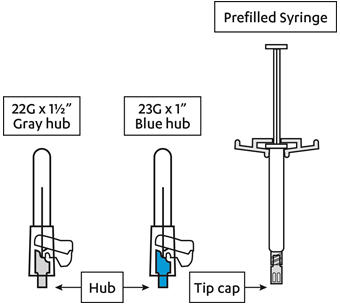
INVEGA SUSTENNA is for single use only.
- Shake the syringe vigorously for a minimum of 10 seconds to ensure a homogeneous suspension.
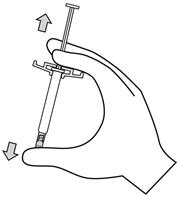
- Select the appropriate needle.
For DELTOID injection:- If the patient weighs less than 90 kg, use the 1-inch 23gauge needle (needle with bluecolored hub).
- If the patient weighs 90 kg or more, use the 1 ½-inch 22gauge needle (needle with graycolored hub).
For GLUTEAL injection:
Use the 1 ½-inch 22gauge needle (needle with graycolored hub) regardless of patient's weight.
-
Hold the syringe with the tip cap pointing up. Remove the rubber tip cap with a gentle twisting motion.
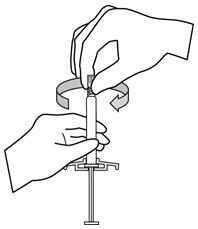
-
Peel the safety needle pouch half way open. Grasp the needle sheath using the plastic peel pouch. Hold the syringe pointing up. Attach the safety needle to the syringe using a gentle twisting motion to avoid needle hub cracks or damage. Always check for signs of damage or leaking prior to administration.
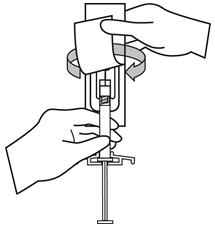
- Pull the needle sheath away from the needle with a straight pull. Do not twist the sheath as the needle may be loosened from the syringe.
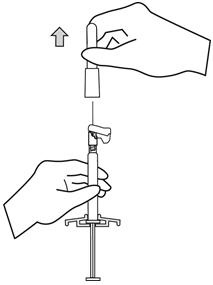
- Bring the syringe with the attached needle in upright position to de-aerate. De-aerate the syringe by moving the plunger rod carefully forward.
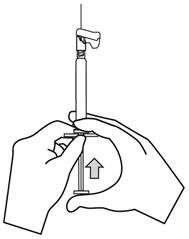
- Inject the entire contents intramuscularly slowly, deep into the selected deltoid or gluteal muscle of the patient. Do not administer by any other route.
- After the injection is complete, use either thumb or finger of one hand (h1, h2) or a flat surface (h3) to activate the needle protection system. The needle protection system is fully activated when a 'click' is heard. Discard the syringe with needle appropriately.
| h1 | |
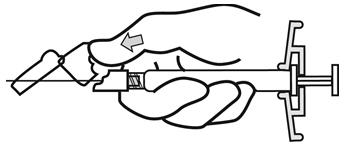 |
|
| h2 | |
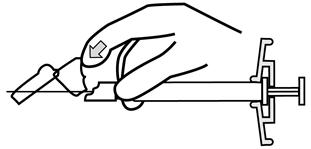 |
|
| h3 | |
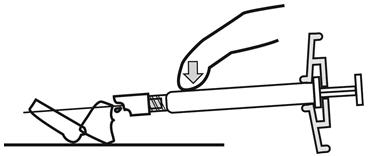 |
|
3. Dosage Forms and Strengths
INVEGA SUSTENNA is available as a white to off-white aqueous extended-release injectable suspension for intramuscular injection in dose strengths of 39 mg/0.25 mL, 78 mg/0.5 mL, 117 mg/0.75 mL, 156 mg/mL, and 234 mg/1.5 mL paliperidone palmitate in single-dose prefilled syringes.
4. Contraindications
INVEGA SUSTENNA is contraindicated in patients with a known hypersensitivity to either paliperidone or risperidone, or to any of the excipients in the INVEGA SUSTENNA formulation. Hypersensitivity reactions, including anaphylactic reactions and angioedema, have been reported in patients treated with risperidone and in patients treated with paliperidone. Paliperidone palmitate is converted to paliperidone, which is a metabolite of risperidone.
5. Warnings and Precautions
5.1 Increased Mortality in Elderly Patients with Dementia-Related Psychosis
Elderly patients with dementia-related psychosis treated with antipsychotic drugs are at an increased risk of death. Analyses of 17 placebo-controlled trials (modal duration of 10 weeks), largely in patients taking atypical antipsychotic drugs, revealed a risk of death in drug-treated patients of between 1.6 to 1.7 times the risk of death in placebo-treated patients. Over the course of a typical 10-week controlled trial, the rate of death in drug-treated patients was about 4.5%, compared to a rate of about 2.6% in the placebo group. Although the causes of death were varied, most of the deaths appeared to be either cardiovascular (e.g., heart failure, sudden death) or infectious (e.g., pneumonia) in nature. Observational studies suggest that, similar to atypical antipsychotic drugs, treatment with conventional antipsychotic drugs may increase mortality. The extent to which the findings of increased mortality in observational studies may be attributed to the antipsychotic drug as opposed to some characteristic(s) of the patients is not clear. INVEGA SUSTENNA is not approved for the treatment of patients with dementia-related psychosis [see Boxed Warningand Warnings and Precautions (5.2)] .
5.2 Cerebrovascular Adverse Reactions, Including Stroke, in Elderly Patients with Dementia-Related Psychosis
In placebo-controlled trials with risperidone, aripiprazole, and olanzapine in elderly subjects with dementia, there was a higher incidence of cerebrovascular adverse reactions (cerebrovascular accidents and transient ischemic attacks) including fatalities compared to placebo-treated subjects. No studies have been conducted with oral paliperidone, INVEGA SUSTENNA, or the 3-month paliperidone palmitate extended-release injectable suspension in elderly patients with dementia. These medicines are not approved for the treatment of patients with dementia-related psychosis [see Boxed Warningand Warnings and Precautions (5.1)] .
5.3 Neuroleptic Malignant Syndrome
Neuroleptic Malignant Syndrome (NMS), a potentially fatal symptom complex, has been reported in association with antipsychotic drugs, including paliperidone.
Clinical manifestations of NMS are hyperpyrexia, muscle rigidity, altered mental status including delirium, and autonomic instability (irregular pulse or blood pressure, tachycardia, diaphoresis, and cardiac dysrhythmia). Additional signs may include elevated creatine phosphokinase, myoglobinuria (rhabdomyolysis), and acute renal failure.
If NMS is suspected, immediately discontinue INVEGA SUSTENNA and provide symptomatic treatment and monitoring.
5.4 QT Prolongation
Paliperidone causes a modest increase in the corrected QT (QTc) interval. The use of paliperidone should be avoided in combination with other drugs that are known to prolong QTc including Class 1A (e.g., quinidine, procainamide) or Class III (e.g., amiodarone, sotalol) antiarrhythmic medications, antipsychotic medications (e.g., chlorpromazine, thioridazine), antibiotics (e.g., gatifloxacin, moxifloxacin), or any other class of medications known to prolong the QTc interval. Paliperidone should also be avoided in patients with congenital long QT syndrome and in patients with a history of cardiac arrhythmias.
Certain circumstances may increase the risk of the occurrence of Torsades de pointes and/or sudden death in association with the use of drugs that prolong the QTc interval, including (1) bradycardia; (2) hypokalemia or hypomagnesemia; (3) concomitant use of other drugs that prolong the QTc interval; and (4) presence of congenital prolongation of the QT interval.
The effects of oral paliperidone on the QT interval were evaluated in a double-blind, active-controlled (moxifloxacin 400 mg single dose), multicenter QT study in adults with schizophrenia and schizoaffective disorder, and in three placebo- and active-controlled 6-week, fixed-dose efficacy trials in adults with schizophrenia.
In the QT study (n=141), the 8 mg dose of immediate-release oral paliperidone (n=50) showed a mean placebo-subtracted increase from baseline in QTcLD of 12.3 msec (90% CI: 8.9; 15.6) on day 8 at 1.5 hours post-dose. The mean steady-state peak plasma concentration for this 8 mg dose of paliperidone immediate release (C max ss= 113 ng/mL) was more than 2-fold the exposure observed with the maximum recommended 234 mg dose of INVEGA SUSTENNA administered in the deltoid muscle (predicted median C max ss= 50 ng/mL). In this same study, a 4 mg dose of the immediate-release oral formulation of paliperidone, for which C max ss= 35 ng/mL, showed an increased placebo-subtracted QTcLD of 6.8 msec (90% CI: 3.6; 10.1) on day 2 at 1.5 hours post-dose.
In the three fixed-dose efficacy studies of oral paliperidone extended release in subjects with schizophrenia, electrocardiogram (ECG) measurements taken at various time points showed only one subject in the oral paliperidone 12 mg group had a change exceeding 60 msec at one time-point on Day 6 (increase of 62 msec).
In the four fixed-dose efficacy studies of INVEGA SUSTENNA in subjects with schizophrenia and in the long-term study in subjects with schizoaffective disorder, no subject experienced a change in QTcLD exceeding 60 msec and no subject had a QTcLD value of > 500 msec at any time point. In the maintenance study in subjects with schizophrenia, no subject had a QTcLD change > 60 msec, and one subject had a QTcLD value of 507 msec (Bazett's QT corrected interval [QTcB] value of 483 msec); this latter subject also had a heart rate of 45 beats per minute.
5.5 Tardive Dyskinesia
Tardive dyskinesia, a syndrome consisting of potentially irreversible, involuntary, dyskinetic movements, may develop in patients treated with antipsychotic drugs. Although the prevalence of the syndrome appears to be highest among the elderly, especially elderly women, it is impossible to predict which patients will develop the syndrome. Whether antipsychotic drug products differ in their potential to cause tardive dyskinesia is unknown.
The risk of developing tardive dyskinesia and the likelihood that it will become irreversible appear to increase with the duration of treatment and the cumulative dose. The syndrome can develop after relatively brief treatment periods, even at low doses. It may also occur after discontinuation of treatment.
Tardive dyskinesia may remit, partially or completely, if antipsychotic treatment is discontinued. Antipsychotic treatment, itself, however, may suppress (or partially suppress) the signs and symptoms of the syndrome, possibly masking the underlying process. The effect that symptomatic suppression has upon the long-term course of the syndrome is unknown.
Given these considerations, INVEGA SUSTENNA should be prescribed in a manner that is most likely to minimize the occurrence of tardive dyskinesia. Chronic antipsychotic treatment should generally be reserved for patients: (1) who suffer from a chronic illness that is known to respond to antipsychotic drugs, and (2) for whom alternative, equally effective, but potentially less harmful treatments are not available or appropriate. In patients who do require chronic treatment, use the lowest dose and the shortest duration of treatment producing a satisfactory clinical response. Periodically reassess the need for continued treatment.
If signs and symptoms of tardive dyskinesia appear in a patient on INVEGA SUSTENNA, drug discontinuation should be considered. However, some patients may require treatment with INVEGA SUSTENNA despite the presence of the syndrome.
5.6 Metabolic Changes
Atypical antipsychotic drugs have been associated with metabolic changes that may increase cardiovascular/cerebrovascular risk. These metabolic changes include hyperglycemia, dyslipidemia, and body weight gain. While all of the drugs in the class have been shown to produce some metabolic changes, each drug has its own specific risk profile.
Hyperglycemia and Diabetes Mellitus
Hyperglycemia and diabetes mellitus, in some cases extreme and associated with ketoacidosis or hyperosmolar coma or death, have been reported in patients treated with all atypical antipsychotics. These cases were, for the most part, seen in post-marketing clinical use and epidemiologic studies, not in clinical trials. Hyperglycemia and diabetes have been reported in trial subjects treated with INVEGA SUSTENNA. Assessment of the relationship between atypical antipsychotic use and glucose abnormalities is complicated by the possibility of an increased background risk of diabetes mellitus in patients with schizophrenia and the increasing incidence of diabetes mellitus in the general population. Given these confounders, the relationship between atypical antipsychotic use and hyperglycemia-related adverse events is not completely understood. However, epidemiological studies suggest an increased risk of hyperglycemia-related adverse reactions in patients treated with the atypical antipsychotics.
Patients with an established diagnosis of diabetes mellitus who are started on atypical antipsychotics should be monitored regularly for worsening of glucose control. Patients with risk factors for diabetes mellitus (e.g., obesity, family history of diabetes) who are starting treatment with atypical antipsychotics should undergo fasting blood glucose testing at the beginning of treatment and periodically during treatment. Any patient treated with atypical antipsychotics should be monitored for symptoms of hyperglycemia including polydipsia, polyuria, polyphagia, and weakness. Patients who develop symptoms of hyperglycemia during treatment with atypical antipsychotics should undergo fasting blood glucose testing. In some cases, hyperglycemia has resolved when the atypical antipsychotic was discontinued; however, some patients required continuation of anti-diabetic treatment despite discontinuation of the suspect drug.
Pooled data from the four placebo-controlled (one 9-week and three 13-week), fixed-dose studies in subjects with schizophrenia are presented in Table 5.
| INVEGA SUSTENNA | |||||||
|---|---|---|---|---|---|---|---|
| Placebo | 39 mg | 78 mg | 156 mg | 234/39 mg * | 234/156 mg * | 234/234 mg * | |
|
|||||||
| Mean change from baseline (mg/dL) | |||||||
| n=367 | n=86 | n=244 | n=238 | n=110 | n=126 | n=115 | |
| Serum Glucose
Change from baseline | -1.3 | 1.3 | 3.5 | 0.1 | 3.4 | 1.8 | -0.2 |
| Proportion of Patients with Shifts | |||||||
| Serum Glucose
Normal to High | 4.6% | 6.3% | 6.4% | 3.9% | 2.5% | 7.0% | 6.6% |
| (<100 mg/dL to ≥126 mg/dL) | (11/241) | (4/64) | (11/173) | (6/154) | (2/79) | (6/86) | (5/76) |
In a long-term open-label pharmacokinetic and safety study in subjects with schizophrenia in which the highest dose available (234 mg) was evaluated, INVEGA SUSTENNA was associated with a mean change in glucose of -0.4 mg/dL at Week 29 (n=109) and +6.8 mg/dL at Week 53 (n=100).
During the initial 25-week open-label period of a long-term study in subjects with schizoaffective disorder, INVEGA SUSTENNA was associated with mean change in glucose of +5.3 mg/dL (n=518). At the endpoint of the subsequent 15-month double-blind period of the study, INVEGA SUSTENNA was associated with a mean change in glucose of +0.3 mg/dL (n=131) compared with a mean change of +4.0 mg/dL in the placebo group (n=120).
Dyslipidemia
Undesirable alterations in lipids have been observed in patients treated with atypical antipsychotics.
Pooled data from the four placebo-controlled (one 9-week and three 13-week), fixed-dose studies in subjects with schizophrenia are presented in Table 6.
| INVEGA SUSTENNA | |||||||
|---|---|---|---|---|---|---|---|
| Placebo | 39 mg | 78 mg | 156 mg | 234/39 mg * | 234/156 mg * | 234/234 mg * | |
|
|||||||
| Mean change from baseline (mg/dL) | |||||||
| Cholesterol | n=366 | n=89 | n=244 | n=232 | n=105 | n=119 | n=120 |
| Change from baseline | -6.6 | -6.4 | -5.8 | -7.1 | -0.9 | -4.2 | 9.4 |
| LDL | n=275 | n=80 | n=164 | n=141 | n=104 | n=117 | n=108 |
| Change from baseline | -6.0 | -4.8 | -5.6 | -4.8 | 0.9 | -2.4 | 5.2 |
| HDL | n=286 | n=89 | n=165 | n=150 | n=105 | n=118 | n=115 |
| Change from baseline | 0.7 | 2.1 | 0.6 | 0.3 | 1.5 | 1.1 | 0.0 |
| Triglycerides | n=366 | n=89 | n=244 | n=232 | n=105 | n=119 | n=120 |
| Change from baseline | -16.7 | 7.6 | -9.0 | -11.5 | -14.1 | -20.0 | 11.9 |
| Proportion of Patients with Shifts | |||||||
| Cholesterol | |||||||
| Normal to High | 3.2% | 2.0% | 2.0% | 2.1% | 0% | 3.1% | 7.1% |
| (<200 mg/dL to ≥240 mg/dL) | (7/222) | (1/51) | (3/147) | (3/141) | (0/69) | (2/65) | (6/84) |
| LDL | |||||||
| Normal to High | 1.1% | 0% | 0% | 0% | 0% | 0% | 0% |
| (<100 mg/dL to ≥160 mg/dL) | (1/95) | (0/29) | (0/67) | (0/46) | (0/41) | (0/37) | (0/44) |
| HDL | |||||||
| Normal to Low | 13.8% | 14.8% | 9.6% | 14.2% | 12.7% | 10.5% | 16.0% |
| (≥40 mg/dL to <40 mg/dL) | (28/203) | (9/61) | (11/115) | (15/106) | (9/71) | (8/76) | (13/81) |
| Triglycerides | |||||||
| Normal to High | 3.6% | 6.1% | 9.2% | 7.2% | 1.3% | 3.7% | 10.7% |
| (<150 mg/dL to ≥200 mg/dL) | (8/221) | (3/49) | (14/153) | (10/139) | (1/79) | (3/82) | (9/84) |
In a long-term open-label pharmacokinetic and safety study in subjects with schizophrenia in which the highest dose available (234 mg) was evaluated, the mean changes from baseline in lipid values are presented in Table 7.
| INVEGA SUSTENNA 234 mg | ||
|---|---|---|
| Week 29 | Week 53 | |
| Mean change from baseline (mg/dL) | ||
| Cholesterol | n=112 | n=100 |
| Change from baseline | -1.2 | 0.1 |
| LDL | n=107 | n=89 |
| Change from baseline | -2.7 | -2.3 |
| HDL | n=112 | n=98 |
| Change from baseline | -0.8 | -2.6 |
| Triglycerides | n=112 | n=100 |
| Change from baseline | 16.2 | 37.4 |
The mean changes from baseline in lipid values during the initial 25-week open-label period and at the endpoint of the subsequent 15-month double-blind period in a long-term study in subjects with schizoaffective disorder are presented in Table 8.
| Open-Label Period | Double-Blind Period | ||
|---|---|---|---|
| INVEGA SUSTENNA | Placebo | INVEGA SUSTENNA | |
| Mean change from baseline (mg/dL) | |||
| Cholesterol | n=198 | n=119 | n=132 |
| Change from baseline | -3.9 | -4.2 | 2.3 |
| LDL | n=198 | n=117 | n=130 |
| Change from baseline | -2.7 | -2.8 | 5.9 |
| HDL | n=198 | n=119 | n=131 |
| Change from baseline | -2.7 | -0.9 | -0.7 |
| Triglycerides | n=198 | n=119 | n=132 |
| Change from baseline | 7.0 | 2.5 | -12.3 |
Weight Gain
Weight gain has been observed with atypical antipsychotic use. Clinical monitoring of weight is recommended.
Data on mean changes in body weight and the proportion of subjects meeting a weight gain criterion of ≥ 7% of body weight from the four placebo-controlled (one 9-week and three 13-week), fixed-dose studies in subjects with schizophrenia are presented in Table 9.
| INVEGA SUSTENNA | |||||||
|---|---|---|---|---|---|---|---|
| Placebo | 39 mg | 78 mg | 156 mg | 234/39 mg * | 234/156 mg * | 234/234 mg * | |
|
|||||||
| n=451 | n=116 | n=280 | n=267 | n=137 | n=144 | n=145 | |
| Weight (kg) Change from baseline | -0.4 | 0.4 | 0.8 | 1.4 | 0.4 | 0.7 | 1.4 |
| Weight Gain ≥ 7% increase from baseline | 3.3% | 6.0% | 8.9% | 9.0% | 5.8% | 8.3% | 13.1% |
In a long-term open-label pharmacokinetic and safety study in which the highest dose available (234 mg) was evaluated, INVEGA SUSTENNA was associated with a mean change in weight of +2.4 kg at Week 29 (n=134) and +4.3 kg at Week 53 (n=113).
During the initial 25-week open-label period of a long-term study in subjects with schizoaffective disorder, INVEGA SUSTENNA was associated with a mean change in weight of +2.2 kg and 18.4% of subjects had an increase in body weight of ≥ 7% (n=653). At the endpoint of the subsequent 15-month double-blind period of the study, INVEGA SUSTENNA was associated with a mean change in weight of -0.2 kg and 13.0% of subjects had an increase in body weight of ≥ 7% (n=161); the placebo group had a mean change in weight of -0.8 kg and 6.0% of subjects had an increase in body weight of ≥ 7% (n=168).
5.7 Orthostatic Hypotension and Syncope
Paliperidone can induce orthostatic hypotension and syncope in some patients because of its alpha-adrenergic blocking activity. Syncope was reported in < 1% (4/1293) of subjects treated with INVEGA SUSTENNA in the recommended dose range of 39 mg to 234 mg in the four fixed-dose, double-blind, placebo-controlled trials compared with 0% (0/510) of subjects treated with placebo. In the four fixed-dose efficacy studies in subjects with schizophrenia, orthostatic hypotension was reported as an adverse event by < 1% (2/1293) of INVEGA SUSTENNA-treated subjects compared to 0% (0/510) with placebo. Incidences of orthostatic hypotension and syncope in the long-term studies in subjects with schizophrenia and schizoaffective disorder were similar to those observed in the short-term studies.
INVEGA SUSTENNA should be used with caution in patients with known cardiovascular disease (e.g., heart failure, history of myocardial infarction or ischemia, conduction abnormalities), cerebrovascular disease, or conditions that predispose the patient to hypotension (e.g., dehydration, hypovolemia, and treatment with antihypertensive medications). Monitoring of orthostatic vital signs should be considered in patients who are vulnerable to hypotension.
5.8 Falls
Somnolence, postural hypotension, motor and sensory instability have been reported with the use of antipsychotics, including INVEGA SUSTENNA, which may lead to falls and, consequently, fractures or other fall-related injuries. For patients, particularly the elderly, with diseases, conditions, or medications that could exacerbate these effects, assess the risk of falls when initiating antipsychotic treatment and recurrently for patients on long-term antipsychotic therapy.
5.9 Leukopenia, Neutropenia, and Agranulocytosis
In clinical trial and/or postmarketing experience, events of leukopenia and neutropenia have been reported temporally related to antipsychotic agents, including INVEGA SUSTENNA. Agranulocytosis has also been reported.
Possible risk factors for leukopenia/neutropenia include pre-existing low white blood cell count (WBC)/absolute neutrophil count (ANC) and history of drug-induced leukopenia/neutropenia. In patients with a history of a clinically significant low WBC/ANC or a drug-induced leukopenia/neutropenia, perform a complete blood count (CBC) frequently during the first few months of therapy. In such patients, consider discontinuation of INVEGA SUSTENNA at the first sign of a clinically significant decline in WBC in the absence of other causative factors.
Monitor patients with clinically significant neutropenia for fever or other symptoms or signs of infection and treat promptly if such symptoms or signs occur. Discontinue INVEGA SUSTENNA in patients with severe neutropenia (absolute neutrophil count < 1000/mm 3) and follow their WBC until recovery.
5.10 Hyperprolactinemia
Like other drugs that antagonize dopamine D 2receptors, paliperidone elevates prolactin levels and the elevation persists during chronic administration. Paliperidone has a prolactin-elevating effect similar to that seen with risperidone, a drug that is associated with higher levels of prolactin than other antipsychotic drugs.
Hyperprolactinemia, regardless of etiology, may suppress hypothalamic GnRH, resulting in reduced pituitary gonadotrophin secretion. This, in turn, may inhibit reproductive function by impairing gonadal steroidogenesis in both female and male patients. Galactorrhea, amenorrhea, gynecomastia, and impotence have been reported in patients receiving prolactin-elevating compounds. Long-standing hyperprolactinemia when associated with hypogonadism may lead to decreased bone density in both female and male subjects.
Tissue culture experiments indicate that approximately one-third of human breast cancers are prolactin dependent in vitro, a factor of potential importance if the prescription of these drugs is considered in a patient with previously detected breast cancer. An increase in the incidence of pituitary gland, mammary gland, and pancreatic islet cell neoplasia (mammary adenocarcinomas, pituitary and pancreatic adenomas) was observed in the risperidone carcinogenicity studies conducted in mice and rats [see Nonclinical Toxicology (13.1)] . Neither clinical studies nor epidemiologic studies conducted to date have shown an association between chronic administration of this class of drugs and tumorigenesis in humans, but the available evidence is too limited to be conclusive.
Prolactin data from two long-term, double-blind, placebo-controlled studies with INVEGA SUSTENNA are presented below; one study was in a population of patients with schizophrenia; the second study was in patients with schizoaffective disorder.
Schizophrenia
In a long-term maintenance trial of INVEGA SUSTENNA in schizophrenia patients (Study PSY-3001), see Clinical Studies (14.1), elevations of prolactin to above the reference range (> 18 ng/mL in males and > 30 ng/mL in females) relative to open-label baseline at any time during the double-blind phase were noted in a higher percentage of the patients in the INVEGA SUSTENNA group than those in the placebo group in males (51.9% vs. 29.0%) and in females (50.5% vs. 42.9%). During the double-blind phase, 4 females (4.2%) in the INVEGA SUSTENNA group experienced potentially prolactin-related adverse reactions (amenorrhea N=2; galactorrhea N=1; menstruation irregular N=1), while 2 females (2.2%) in the placebo group experienced potentially prolactin-related adverse reactions (amenorrhea N=1; breast pain N=1). One male (0.9%) in the INVEGA SUSTENNA group experienced erectile dysfunction and 1 male (0.9%) in placebo group experienced gynecomastia.
Prior to the double-blind phase (during the 33-week open-label phase of the long-term maintenance trial), the mean (SD) serum prolactin values at baseline were 14.9 (22.3) ng/mL in males (N=490) and 35.2 (39.6) ng/mL in females (N=358). At the end of the open-label phase, mean (SD) prolactin values were 24.7 (22.5) ng/mL in males (N=470) and 59.5 (38.1) ng/mL in females (N=333). During the open-label phases 49.2% of females and 47.7% of males experienced elevations of prolactin above the reference range relative to baseline, and a higher proportion of females experienced potentially prolactin-related adverse reactions compared to males (5.3% vs. 1.8%). Amenorrhea (2.5%) in females and no single potentially prolactin-related adverse reaction in males were observed with a rate greater than 2%.
Schizoaffective Disorder
In a long-term maintenance trial of INVEGA SUSTENNA in patients with schizoaffective disorder (Study SCA-3004) see Clinical Studies (14.2), elevations of prolactin to above the reference range (> 13.13 ng/mL in males and > 26.72 ng/mL in females) relative to open-label baseline at any time during the 15-month double-blind phase were noted in a higher percentage of patients in the INVEGA SUSTENNA group than those in the placebo group in males (55.6% vs. 23.2%) and in females (44.3% vs. 25.0%). During the 15-month double-blind phase, 11 females (13.9%) in the INVEGA SUSTENNA group had 14 potentially prolactin-related adverse reactions (hyperprolactinemia N=3; blood prolactin increased N=4; libido decreased N=1; amenorrhea N=3; galactorrhea N=3), while 5 females (5.8%) in the placebo group had 6 potentially prolactin-related adverse reactions (hyperprolactinemia N=2; blood prolactin increased N=1; amenorrhea N=2; galactorrhea N=1). Six males (7.1%) in the INVEGA SUSTENNA group experienced 6 potentially prolactin-related adverse reactions (hyperprolactinemia N=4; libido decreased N=1; erectile dysfunction N=1), while 1 male (1.2%) in the placebo group experienced adverse reaction of blood prolactin increased.
Prior to the 15-month double-blind phase (during the 25-week open-label phase of the long-term maintenance trial), the mean (SD) serum prolactin values at baseline were 14.6 (14.0) ng/mL in males (N=352) and 39.1 (44.6) ng/mL in females (N=302). At the end of the open-label phase, mean (SD) prolactin values were 32.8 (17.2) ng/mL in males (N=275) and 72.4 (46.5) ng/mL in females (N=239). During the open-label phase, 48.9% of females and 53.3% of males experienced elevations of prolactin above the reference range relative to baseline, and a higher proportion of females experienced potentially prolactin-related adverse reactions compared to males (10.0% vs. 9.0%). Amenorrhea (5.8%) and galactorrhea (2.9%) in females and libido decrease (2.8%) and erectile dysfunction (2.5%) in males were observed with a rate greater than 2%.
5.11 Potential for Cognitive and Motor Impairment
Somnolence, sedation, and dizziness were reported as adverse reactions in subjects treated with INVEGA SUSTENNA [see Adverse Reactions (6.1)] . Antipsychotics, including INVEGA SUSTENNA, have the potential to impair judgment, thinking, or motor skills. Patients should be cautioned about performing activities requiring mental alertness, such as operating hazardous machinery or operating a motor vehicle, until they are reasonably certain that paliperidone therapy does not adversely affect them.
5.12 Seizures
In the four fixed-dose double-blind placebo-controlled studies in subjects with schizophrenia, <1% (1/1293) of subjects treated with INVEGA SUSTENNA in the recommended dose range of 39 mg to 234 mg experienced an adverse event of convulsion compared with <1% (1/510) of placebo-treated subjects who experienced an adverse event of grand mal convulsion.
Like other antipsychotic drugs, INVEGA SUSTENNA should be used cautiously in patients with a history of seizures or other conditions that potentially lower the seizure threshold. Conditions that lower the seizure threshold may be more prevalent in patients 65 years or older.
5.13 Dysphagia
Esophageal dysmotility and aspiration have been associated with antipsychotic drug use. INVEGA SUSTENNA and other antipsychotic drugs should be used cautiously in patients at risk for aspiration pneumonia.
5.14 Priapism
Drugs with alpha-adrenergic blocking effects have been reported to induce priapism. Although no cases of priapism have been reported in clinical trials with INVEGA SUSTENNA, priapism has been reported with oral paliperidone during postmarketing surveillance. Severe priapism may require surgical intervention.
5.15 Disruption of Body Temperature Regulation
Disruption of the body's ability to reduce core body temperature has been attributed to antipsychotic agents. Appropriate care is advised when prescribing INVEGA SUSTENNA to patients who will be experiencing conditions which may contribute to an elevation in core body temperature, e.g., exercising strenuously, exposure to extreme heat, receiving concomitant medication with anticholinergic activity, or being subject to dehydration.
6. Adverse Reactions/Side Effects
The following are discussed in more detail in other sections of the labeling:
- Increased mortality in elderly patients with dementia-related psychosis [see Boxed Warningand Warnings and Precautions (5.1)]
- Cerebrovascular adverse reactions, including stroke, in elderly patients with dementia-related psychosis [see Warnings and Precautions (5.2)]
- Neuroleptic malignant syndrome [see Warnings and Precautions (5.3)]
- QT prolongation [see Warnings and Precautions (5.4)]
- Tardive dyskinesia [see Warnings and Precautions (5.5)]
- Metabolic changes [see Warnings and Precautions (5.6)]
- Orthostatic hypotension and syncope [see Warnings and Precautions (5.7)]
- Falls [see Warnings and Precautions (5.8)]
- Leukopenia, neutropenia, and agranulocytosis [see Warnings and Precautions (5.9)]
- Hyperprolactinemia [see Warnings and Precautions (5.10)]
- Potential for cognitive and motor impairment [see Warnings and Precautions (5.11)]
- Seizures [see Warnings and Precautions (5.12)]
- Dysphagia [see Warnings and Precautions (5.13)]
- Priapism [see Warnings and Precautions (5.14)]
- Disruption of body temperature regulation [see Warnings and Precautions (5.15)]
6.1 Clinical Trials Experience
Because clinical trials are conducted under widely varying conditions, adverse reaction rates observed in the clinical trials of a drug cannot be directly compared to rates in the clinical trials of another drug and may not reflect the rates observed in clinical practice.
Patient Exposure
The data described in this section are derived from a clinical trial database consisting of a total of 3817 subjects (approximately 1705 patient-years exposure) with schizophrenia who received at least one dose of INVEGA SUSTENNA in the recommended dose range of 39 mg to 234 mg and a total of 510 subjects with schizophrenia who received placebo. Among the 3817 INVEGA SUSTENNA-treated subjects, 1293 received INVEGA SUSTENNA in four fixed-dose, double-blind, placebo-controlled trials (one 9-week and three 13-week studies), 849 received INVEGA SUSTENNA in the maintenance trial (median exposure 229 days during the initial 33-week open-label phase of this study, of whom 205 continued to receive INVEGA SUSTENNA during the double-blind placebo-controlled phase of this study [median exposure 171 days]), and 1675 received INVEGA SUSTENNA in five non-placebo controlled trials (three noninferiority active-comparator trials, one long-term open-label pharmacokinetic and safety study, and an injection site [deltoid-gluteal] cross-over trial). One of the 13-week studies included a 234 mg INVEGA SUSTENNA initiation dose followed by treatment with either 39 mg, 156 mg, or 234 mg every 4 weeks.
The safety of INVEGA SUSTENNA was also evaluated in a 15-month, long-term study comparing INVEGA SUSTENNA to selected oral antipsychotic therapies in adult subjects with schizophrenia. A total of 226 subjects received INVEGA SUSTENNA during the 15-month, open-label period of this study; 218 subjects received selected oral antipsychotic therapies. The safety of INVEGA SUSTENNA was similar to that seen in previous double-blind, placebo-controlled clinical trials in adult subjects with schizophrenia.
The safety of INVEGA SUSTENNA was also evaluated in a long-term study in adult subjects with schizoaffective disorder. A total of 667 subjects received INVEGA SUSTENNA during the initial 25-week open-label period of this study (median exposure 147 days); 164 subjects continued to receive INVEGA SUSTENNA during the 15-month double-blind placebo-controlled period of this study (median exposure 446 days). Adverse reactions that occurred more frequently in the INVEGA SUSTENNA than the placebo group (a 2% difference or more between groups) were weight increased, nasopharyngitis, headache, hyperprolactinemia, and pyrexia.
Adverse Reactions in Double-Blind, Placebo-Controlled Clinical Trials
Commonly Observed Adverse Reactions:The most common (at least 5% in any INVEGA SUSTENNA group) and likely drug-related (adverse events for which the drug rate is at least twice the placebo rate) adverse reactions from the double-blind, placebo-controlled trials in subjects with schizophrenia were injection site reactions, somnolence/sedation, dizziness, akathisia, and extrapyramidal disorder .No occurrences of adverse events reached this threshold in the long-term double-blind, placebo-controlled study in subjects with schizoaffective disorder.
Discontinuation of Treatment Due to Adverse Events:The percentage of subjects who discontinued due to adverse events in the four fixed-dose, double-blind, placebo-controlled schizophrenia trials were similar for INVEGA SUSTENNA- and placebo-treated subjects.
The percentage of subjects who discontinued due to adverse events in the open-label period of the long-term study in subjects with schizoaffective disorder was 7.5%. During the double-blind, placebo-controlled period of that study, the percentages of subjects who discontinued due to adverse events were 5.5% and 1.8% in INVEGA SUSTENNA- and placebo-treated subjects, respectively.
Dose-Related Adverse Reactions:Based on the pooled data from the four fixed-dose, double-blind, placebo-controlled trials in subjects with schizophrenia, among the adverse reactions that occurred with ≥ 2% incidence in the subjects treated with INVEGA SUSTENNA, only akathisia increased with dose. Hyperprolactinemia also exhibited a dose relationship, but did not occur at ≥ 2% incidence in INVEGA SUSTENNA-treated subjects from the four fixed-dose studies.
Adverse Reactions Occurring at an Incidence of 2% or More in INVEGA SUSTENNA-Treated Patients:Table 10 lists the adverse reactions reported in 2% or more of INVEGA SUSTENNA-treated subjects and at a greater proportion than in the placebo group with schizophrenia in the four fixed-dose, double-blind, placebo-controlled trials.
| INVEGA SUSTENNA | |||||||
|---|---|---|---|---|---|---|---|
| System Organ Class | Placebo * | 39 mg | 78 mg | 156 mg | 234/39 mg † | 234/156 mg † | 234/234 mg † |
| Adverse Reactions | (N=510) | (N=130) | (N=302) | (N=312) | (N=160) | (N=165) | (N=163) |
| Percentages are rounded to whole numbers. Table includes adverse reactions that were reported in 2% or more of subjects in any of the INVEGA SUSTENNA dose groups and which occurred at greater incidence than in the placebo group. | |||||||
|
|||||||
| Total percentage of subjects with adverse reactions | 70 | 75 | 68 | 69 | 63 | 60 | 63 |
| Gastrointestinal disorders | |||||||
| Abdominal discomfort/abdominal pain upper | 2 | 2 | 4 | 4 | 1 | 2 | 4 |
| Diarrhea | 2 | 0 | 3 | 2 | 1 | 2 | 2 |
| Dry mouth | 1 | 3 | 1 | 0 | 1 | 1 | 1 |
| Nausea | 3 | 4 | 4 | 3 | 2 | 2 | 2 |
| Toothache | 1 | 1 | 1 | 3 | 1 | 2 | 3 |
| Vomiting | 4 | 5 | 4 | 2 | 3 | 2 | 2 |
| General disorders and administration site conditions | |||||||
| Asthenia | 0 | 2 | 1 | <1 | 0 | 1 | 1 |
| Fatigue | 1 | 1 | 2 | 2 | 1 | 2 | 1 |
| Injection site reactions | 2 | 0 | 4 | 6 | 9 | 7 | 10 |
| Infections and infestations | |||||||
| Nasopharyngitis | 2 | 0 | 2 | 2 | 4 | 2 | 2 |
| Upper respiratory tract infection | 2 | 2 | 2 | 2 | 1 | 2 | 4 |
| Urinary tract infection | 1 | 0 | 1 | <1 | 1 | 1 | 2 |
| Investigations | |||||||
| Weight increased | 1 | 4 | 4 | 1 | 1 | 1 | 2 |
| Musculoskeletal and connective tissue disorders | |||||||
| Back pain | 2 | 2 | 1 | 3 | 1 | 1 | 1 |
| Musculoskeletal stiffness | 1 | 1 | <1 | <1 | 1 | 1 | 2 |
| Myalgia | 1 | 2 | 1 | <1 | 1 | 0 | 2 |
| Pain in extremity | 1 | 0 | 2 | 2 | 2 | 3 | 0 |
| Nervous system disorders | |||||||
| Akathisia | 3 | 2 | 2 | 3 | 1 | 5 | 6 |
| Dizziness | 1 | 6 | 2 | 4 | 1 | 4 | 2 |
| Extrapyramidal disorder | 1 | 5 | 2 | 3 | 1 | 0 | 0 |
| Headache | 12 | 11 | 11 | 15 | 11 | 7 | 6 |
| Somnolence/sedation | 3 | 5 | 7 | 4 | 1 | 5 | 5 |
| Psychiatric disorders | |||||||
| Agitation | 7 | 10 | 5 | 9 | 8 | 5 | 4 |
| Anxiety | 7 | 8 | 5 | 3 | 5 | 6 | 6 |
| Nightmare | <1 | 2 | 0 | 0 | 0 | 0 | 0 |
| Respiratory, thoracic and mediastinal disorders | |||||||
| Cough | 1 | 2 | 3 | 1 | 0 | 1 | 1 |
| Vascular disorders | |||||||
| Hypertension | 1 | 2 | 1 | 1 | 1 | 1 | 0 |
Adverse reactions for which the INVEGA SUSTENNA incidence was equal to or less than placebo are not listed in the table, but included the following: dyspepsia, psychotic disorder, schizophrenia, and tremor. The following terms were combined: somnolence/sedation, breast tenderness/breast pain, abdominal discomfort/abdominal pain upper/stomach discomfort, and tachycardia/sinus tachycardia/heart rate increased. All injection site reaction-related adverse reactions were collapsed and are grouped under "Injection site reactions".
Other Adverse Reactions Observed During the Clinical Trial Evaluation of INVEGA SUSTENNA
The following list does not include reactions: 1) already listed in previous tables or elsewhere in labeling, 2) for which a drug cause was remote, 3) which were so general as to be uninformative, or 4) which were not considered to have significant clinical implications.
Cardiac disorders:atrioventricular block first degree, bradycardia, bundle branch block, palpitations, postural orthostatic tachycardia syndrome, tachycardia
Ear and labyrinth disorders:vertigo
Eye disorders:eye movement disorder, eye rolling, oculogyric crisis, vision blurred
Gastrointestinal disorders:constipation, dyspepsia, flatulence, salivary hypersecretion
Immune system disorders:hypersensitivity
Investigations:alanine aminotransferase increased, aspartate aminotransferase increased, electrocardiogram abnormal
Metabolism and nutrition disorders:decreased appetite, hyperinsulinemia, increased appetite
Musculoskeletal and connective tissue disorders:arthralgia, joint stiffness, muscle rigidity, muscle spasms, muscle tightness, muscle twitching, nuchal rigidity
Nervous system disorders:bradykinesia, cerebrovascular accident, cogwheel rigidity, convulsion, dizziness postural, drooling, dysarthria, dyskinesia, dystonia, hypertonia, lethargy, oromandibular dystonia, parkinsonism, psychomotor hyperactivity, syncope
Psychiatric disorders:insomnia, libido decreased, restlessness
Reproductive system and breast disorders:amenorrhea, breast discharge, breast enlargement/breast swelling, breast tenderness/breast pain, ejaculation disorder, erectile dysfunction, galactorrhea, gynecomastia, menstrual disorder, menstruation delayed, menstruation irregular, sexual dysfunction
Respiratory, thoracic and mediastinal disorders:nasal congestion
Skin and subcutaneous tissue disorders:drug eruption, pruritus, pruritus generalized, rash, urticaria
Demographic Differences
An examination of population subgroups in the double-blind placebo-controlled trials did not reveal any evidence of differences in safety on the basis of age, gender, or race alone; however, there were few subjects 65 years of age and older.
Extrapyramidal Symptoms (EPS)
Pooled data from the two double-blind, placebo-controlled, 13-week, fixed-dose trials in adult subjects with schizophrenia provided information regarding EPS. Several methods were used to measure EPS: (1) the Simpson-Angus global score which broadly evaluates parkinsonism, (2) the Barnes Akathisia Rating Scale global clinical rating score which evaluates akathisia, (3) the Abnormal Involuntary Movement Scale scores which evaluates dyskinesia, and (4) use of anticholinergic medications to treat EPS (Table 11), and (5) incidence of spontaneous reports of EPS (Table 12).
| Percentage of Subjects | ||||
|---|---|---|---|---|
| INVEGA SUSTENNA | ||||
| Scale | Placebo
(N=262) | 39 mg
(N=130) | 78 mg
(N=223) | 156 mg
(N=228) |
|
||||
| Parkinsonism * | 9 | 12 | 10 | 6 |
| Akathisia † | 5 | 5 | 6 | 5 |
| Dyskinesia ‡ | 3 | 4 | 6 | 4 |
| Use of Anticholinergic Medications § | 12 | 10 | 12 | 11 |
| Percentage of Subjects | ||||
|---|---|---|---|---|
| INVEGA SUSTENNA | ||||
| EPS Group | Placebo
(N=262) | 39 mg
(N=130) | 78 mg
(N=223) | 156 mg
(N=228) |
| Parkinsonism group includes: Extrapyramidal disorder, hypertonia, musculoskeletal stiffness, parkinsonism, drooling, masked facies, muscle tightness, hypokinesia
Hyperkinesia group includes: Akathisia, restless legs syndrome, restlessness Dyskinesia group includes: Dyskinesia, choreoathetosis, muscle twitching, myoclonus, tardive dyskinesia Dystonia group includes: Dystonia, muscle spasms |
||||
| Overall percentage of subjects with EPS-related adverse events | 10 | 12 | 11 | 11 |
| Parkinsonism | 5 | 6 | 6 | 4 |
| Hyperkinesia | 2 | 2 | 2 | 4 |
| Tremor | 3 | 2 | 2 | 3 |
| Dyskinesia | 1 | 2 | 3 | 1 |
| Dystonia | 0 | 1 | 1 | 2 |
The results across all phases of the maintenance trial in subjects with schizophrenia exhibited comparable findings. In the 9-week, fixed-dose, double-blind, placebo-controlled trial, the proportions of parkinsonism and akathisia assessed by incidence of rating scales were higher in the INVEGA SUSTENNA 156 mg group (18% and 11%, respectively) than in the INVEGA SUSTENNA 78 mg group (9% and 5%, respectively) and placebo group (7% and 4%, respectively).
In the 13-week study in subjects with schizophrenia involving 234 mg initiation dosing, the incidence of any EPS was similar to that of the placebo group (8%), but exhibited a dose-related pattern with 6%, 10%, and 11% in the INVEGA SUSTENNA 234/39 mg, 234/156 mg, and 234/234 mg groups, respectively. Hyperkinesia was the most frequent category of EPS-related adverse events in this study, and was reported at a similar rate between the placebo (4.9%) and INVEGA SUSTENNA 234/156 mg (4.8%) and 234/234 mg (5.5%) groups, but at a lower rate in the 234/39 mg group (1.3%).
In the long-term study in subjects with schizoaffective disorder, EPS reported during the 25-week open-label INVEGA SUSTENNA treatment included hyperkinesia (12.3%), parkinsonism (8.7%), tremor (3.4%), dyskinesia (2.5%), and dystonia (2.1%). During the 15-month double-blind treatment, the incidence of any EPS was similar to that of the placebo group (8.5% and 7.1% respectively). The most commonly reported treatment-emergent EPS-related adverse events (> 2%) in any treatment group in the double-blind phase of the study (INVEGA SUSTENNA versus placebo) were hyperkinesia (3.7% vs. 2.9%), parkinsonism (3.0% vs. 1.8%), and tremor (1.2% vs. 2.4%).
Dystonia
Symptoms of dystonia, prolonged abnormal contractions of muscle groups, may occur in susceptible individuals during the first few days of treatment. Dystonic symptoms include: spasm of the neck muscles, sometimes progressing to tightness of the throat, swallowing difficulty, difficulty breathing, and/or protrusion of the tongue. While these symptoms can occur at low doses, they occur more frequently and with greater severity with high potency and at higher doses of first generation antipsychotic drugs. An elevated risk of acute dystonia is observed in males and younger age groups.
Pain Assessment and Local Injection Site Reactions
In the pooled data from the two 13-week, fixed-dose, double-blind, placebo-controlled trials in subjects with schizophrenia, the mean intensity of injection pain reported by subjects using a visual analog scale (0 = no pain to 100 = unbearably painful) decreased in all treatment groups from the first to the last injection (placebo: 10.9 to 9.8; 39 mg: 10.3 to 7.7; 78 mg: 10.0 to 9.2; 156 mg: 11.1 to 8.8). The results from both the 9-week, fixed-dose, double-blind, placebo-controlled trial and the double-blind phase of the maintenance trial exhibited comparable findings.
In the 13-week study involving 234 mg initiation dosing in subjects with schizophrenia, occurrences of induration, redness, or swelling, as assessed by blinded study personnel, were infrequent, generally mild, decreased over time, and similar in incidence between the INVEGA SUSTENNA and placebo groups. Investigator ratings of injection pain were similar for the placebo and INVEGA SUSTENNA groups. Investigator evaluations of the injection site after the first injection for redness, swelling, induration, and pain were rated as absent for 69–100% of subjects in both the INVEGA SUSTENNA and placebo groups. At Day 92, investigators rated absence of redness, swelling, induration, and pain in 95–100% of subjects in both the INVEGA SUSTENNA and placebo groups.
Additional Adverse Reactions Reported in Clinical Trials with Oral Paliperidone
The following is a list of additional adverse reactions that have been reported in clinical trials with oral paliperidone:
Cardiac disorders: bundle branch block left, sinus arrhythmia
Gastrointestinal disorders: abdominal pain, small intestinal obstruction
General disorders and administration site conditions: edema, edema peripheral
Immune system disorders: anaphylactic reaction
Infections and infestations:rhinitis
Musculoskeletal and connective tissue disorders: musculoskeletal pain, torticollis, trismus
Nervous system disorders: grand mal convulsion, parkinsonian gait, transient ischemic attack
Psychiatric disorders:sleep disorder
Reproductive system and breast disorders: breast engorgement
Respiratory, thoracic and mediastinal disorders:pharyngolaryngeal pain, pneumonia aspiration
Skin and subcutaneous tissue disorders:rash papular
Vascular disorders: hypotension, ischemia
6.2 Postmarketing Experience
The following adverse reactions have been identified during postapproval use of paliperidone; because these reactions were reported voluntarily from a population of uncertain size, it is not always possible to reliably estimate their frequency or establish a causal relationship to drug exposure: angioedema, catatonia, ileus, somnambulism, swollen tongue, thrombotic thrombocytopenic purpura, urinary incontinence, and urinary retention.
Cases of anaphylactic reaction after injection with INVEGA SUSTENNA have been reported during postmarketing experience in patients who have previously tolerated oral risperidone or oral paliperidone.
Paliperidone is the major active metabolite of risperidone. Adverse reactions reported with oral risperidone and risperidone long-acting injection can be found in the Adverse Reactions (6)sections of the package inserts for those products.
7. Drug Interactions
7.1 Drugs Having Clinically Important Interactions with INVEGA SUSTENNA
Because paliperidone palmitate is hydrolyzed to paliperidone [see Clinical Pharmacology (12.3)] , results from studies with oral paliperidone should be taken into consideration when assessing drug-drug interaction potential.
| Concomitant Drug Name or Drug Class | Clinical Rationale | Clinical Recommendation |
|---|---|---|
| Centrally Acting Drugs and Alcohol | Given the primary CNS effects of paliperidone, concomitant use of centrally acting drugs and alcohol may modulate the CNS effects of INVEGA SUSTENNA. | INVEGA SUSTENNA should be used with caution in combination with other centrally acting drugs and alcohol [see Adverse Reactions (6.1, 6.2)] . |
| Drugs with Potential for Inducing Orthostatic Hypotension | Because INVEGA SUSTENNA has the potential for inducing orthostatic hypotension, an additive effect may occur when INVEGA SUSTENNA is administered with other therapeutic agents that have this potential [see Warnings and Precautions (5.7)] . | Monitor orthostatic vital signs in patients who are vulnerable to hypotension [see Warnings and Precautions (5.7)] . |
| Strong Inducers of CYP3A4 and P-gp (e.g., carbamazepine, rifampin, or St. John's Wort) | The concomitant use of paliperidone and strong inducers of CYP3A4 and P-gp may decrease the exposure of paliperidone [see Clinical Pharmacology (12.3)] . | Avoid using CYP3A4 and/or P-gp inducers with INVEGA SUSTENNA during the 1-month dosing interval, if possible. If administering a strong inducer is necessary, consider managing the patient using paliperidone extended-release tablets [see Dosage and Administration (2.5)] . |
| Levodopa and Other Dopamine Agonists | Paliperidone may antagonize the effect of levodopa and other dopamine agonists. | Monitor and manage patient as clinically appropriate. |
7.2 Drugs Having No Clinically Important Interactions with INVEGA SUSTENNA
Clinically meaningful pharmacokinetic interaction between INVEGA SUSTENNA and valproate (including valproic acid and divalproex sodium) is not expected. Based on pharmacokinetic studies with oral paliperidone, no dosage adjustment of INVEGA SUSTENNA is required when administered with valproate [see Clinical Pharmacology (12.3)]. Additionally, no dosage adjustment is necessary for valproate when co-administered with INVEGA SUSTENNA [See Clinical Pharmacology (12.3)].
Pharmacokinetic interaction between lithium and INVEGA SUSTENNA is also unlikely.
Paliperidone is not expected to cause clinically important pharmacokinetic interactions with drugs that are metabolized by cytochrome P450 isozymes. In vitrostudies indicate that CYP2D6 and CYP3A4 may be involved in paliperidone metabolism; however, there is no evidence in vivothat inhibitors of these enzymes significantly affect the metabolism of paliperidone. Paliperidone is not a substrate of CYP1A2, CYP2A6, CYP2C9, and CYP2C19; an interaction with inhibitors or inducers of these isozymes is unlikely. [see Clinical Pharmacology (12.3)]
8. Use In Specific Populations
8.1 Pregnancy
Pregnancy Exposure Registry
There is a pregnancy exposure registry that monitors pregnancy outcomes in women exposed to atypical antipsychotics, including INVEGA SUSTENNA, during pregnancy. Healthcare providers are encouraged to register patients by contacting the National Pregnancy Registry for Atypical Antipsychotics at 1-866-961-2388 or online at http://womensmentalhealth.org/clinical-and-research-programs/pregnancyregistry/.
Risk Summary
Neonates exposed to antipsychotic drugs during the third trimester of pregnancy are at risk for extrapyramidal and/or withdrawal symptoms following delivery (see Clinical Considerations) . Overall, available data from published epidemiologic studies of pregnant women exposed to paliperidone have not established a drug-associated risk for major birth defects, miscarriage, or adverse maternal or fetal outcomes (see Data) . There are risks to the mother associated with untreated schizophrenia and with exposure to antipsychotics, including INVEGA SUSTENNA, during pregnancy (see Clinical Considerations). Paliperidone has been detected in plasma in adult subjects up to 126 days after a single-dose administration of INVEGA SUSTENNA [see Clinical Pharmacology (12.3)] , and the clinical significance of INVEGA SUSTENNA administered before pregnancy or anytime during pregnancy is not known.
The estimated background risk of major birth defects and miscarriage for the indicated population is unknown. All pregnancies have a background risk of birth defects, loss, or other adverse outcomes. In the U.S. general population, the estimated background risk of major birth defects and miscarriage in clinically recognized pregnancies is 2–4% and 15–20%, respectively.
In animal reproduction studies, there were no treatment related effects on the offspring when pregnant rats were injected intramuscularly with paliperidone palmitate during the period of organogenesis at doses up to 10 times the maximum recommended human dose (MRHD) of 234 mg paliperidone based on mg/m 2body surface area. There were no increases in fetal abnormalities when pregnant rats and rabbits were treated orally with paliperidone during the period of organogenesis with up to 8 times the MRHD of 12 mg of paliperidone based on mg/m 2body surface area. Additional reproduction toxicity studies were conducted with orally administered risperidone, which is extensively converted to paliperidone (see Animal data).
Clinical Considerations
Disease-associated maternal and/or embryo/fetal risk
There is a risk to the mother from untreated schizophrenia, including increased risk of relapse, hospitalization, and suicide. Schizophrenia and bipolar I disorder are associated with increased adverse perinatal outcomes, including preterm birth. It is not known if this is a direct result of the illness or other comorbid factors.
Fetal/Neonatal Adverse Reactions
Extrapyramidal and/or withdrawal symptoms, including agitation, hypertonia, hypotonia, tremor, somnolence, respiratory distress, and feeding disorder have been reported in neonates who were exposed to antipsychotic drugs, including INVEGA SUSTENNA, during the third trimester of pregnancy. These symptoms have varied in severity. Monitor neonates exhibiting extrapyramidal and/or withdrawal symptoms and manage symptoms appropriately. Some neonates recovered within hours or days without specific treatment; others required prolonged hospitalization.
Data
Human Data
Published data from observational studies, birth registries, and case reports on the use of atypical antipsychotics during pregnancy do not report a clear association with antipsychotics and major birth defects. A prospective observational study including 6 women treated with risperidone, the parent compound of paliperidone, demonstrated placental passage of risperidone and paliperidone. A retrospective cohort study from a Medicaid database of 9258 women exposed to antipsychotics during pregnancy did not indicate an overall increased risk for major birth defects. There was a small increase in the risk of major birth defects (RR= 1.26, 95% CI 1.02–1.56) and of cardiac malformations (RR=1.26, 95% CI 0.88–1.81) in a subgroup of 1566 women exposed to the parent compound of paliperidone, risperidone, during the first trimester of pregnancy; however, there is no mechanism of action to explain the difference in malformation rates.
Animal Data
There were no treatment-related effects on the offspring when pregnant rats were injected intramuscularly with paliperidone palmitate extended-release injectable suspension during the period of organogenesis at doses up to 250 mg/kg, which is 10 times MRHD of 234 mg paliperidone based on mg/m 2body surface area.
In animal reproduction studies, there were no increases in fetal abnormalities when pregnant rats and rabbits were treated orally with paliperidone during the period of organogenesis with up to 8 times the MRHD of 12 mg based on mg/m 2body surface area.
Additional reproduction toxicity studies were conducted with orally administered risperidone, which is extensively converted to paliperidone. Cleft palate was observed in the offspring of pregnant mice treated with risperidone at 3 to 4 times the MRHD of 16 mg based on mg/m 2body surface area; maternal toxicity occurred at 4 times the MHRD. There was no evidence of teratogenicity in embryo-fetal developmental toxicity studies with risperidone in rats and rabbits at doses up to 6 times the MRHD of 16 mg/day risperidone based on mg/m 2body surface area. When the offspring of pregnant rats, treated with risperidone at 0.6 times the MRHD based on mg/m 2body surface area, reached adulthood, learning was impaired. Increased neuronal cell death occurred in the fetal brains of the offspring of pregnant rats treated at 0.5 to 1.2 times the MRHD; the postnatal development and growth of the offspring was delayed.
In rat reproduction studies with risperidone, pup deaths occurred at oral doses which are less than the MRHD of risperidone based on mg/m 2body surface area; it is not known whether these deaths were due to a direct effect on the fetuses or pups or, to effects on the dams (see RISPERDAL package insert).
8.2 Lactation
Risk Summary
Limited data from published literature report the presence of paliperidone in human breast milk. There is no information on the effects on the breastfed infant or the effects on milk production; however, there are reports of sedation, failure to thrive, jitteriness, and extrapyramidal symptoms (tremors and abnormal muscle movements) in breastfed infants exposed to paliperidone's parent compound, risperidone (see Clinical Considerations) . Paliperidone has been detected in plasma in adult subjects up to 126 days after a single-dose administration of INVEGA SUSTENNA [see Clinical Pharmacology (12.3)] , and the clinical significance on the breastfed infant is not known. The developmental and health benefits of breastfeeding should be considered along with the mother's clinical need for INVEGA SUSTENNA and any potential adverse effects on the breastfed child from INVEGA SUSTENNA or from the mother's underlying condition.
8.3 Females and Males of Reproductive Potential
Infertility
Females
Based on the pharmacologic action of paliperidone (D2 receptor antagonism), treatment with INVEGA SUSTENNA may result in an increase in serum prolactin levels, which may lead to a reversible reduction in fertility in females of reproductive potential [see Warnings and Precautions (5.10)].
8.4 Pediatric Use
Safety and effectiveness of INVEGA SUSTENNA in patients < 18 years of age have not been established.
Juvenile Animal Studies
In a study in which juvenile rats were treated with oral paliperidone from days 24 to 73 of age, a reversible impairment of performance in a test of learning and memory was seen, in females only, with a no-effect dose of 0.63 mg/kg/day, which produced plasma levels (AUC) of paliperidone similar to those in adolescents dosed at 12 mg/day. No other consistent effects on neurobehavioral or reproductive development were seen up to the highest dose tested (2.5 mg/kg/day), which produced plasma levels of paliperidone 2–3 times those in adolescents.
Juvenile dogs were treated for 40 weeks with oral risperidone, which is extensively metabolized to paliperidone in animals and humans, at doses of 0.31, 1.25, or 5 mg/kg/day. Decreased bone length and density were seen with a no-effect dose of 0.31 mg/kg/day, which produced plasma levels (AUC) of risperidone plus paliperidone which were similar to those in children and adolescents receiving the MRHD of risperidone. In addition, a delay in sexual maturation was seen at all doses in both males and females. The above effects showed little or no reversibility in females after a 12-week drug-free recovery period.
The long-term effects of INVEGA SUSTENNA on growth and sexual maturation have not been fully evaluated in children and adolescents.
8.5 Geriatric Use
Clinical studies of INVEGA SUSTENNA did not include sufficient numbers of subjects aged 65 and over to determine whether they respond differently from younger subjects. Other reported clinical experience has not identified differences in responses between the elderly and younger patients.
This drug is known to be substantially excreted by the kidney and clearance is decreased in patients with renal impairment [see Clinical Pharmacology (12.3)] , who should be given reduced doses. Because elderly patients are more likely to have decreased renal function, adjust dose based on renal function [see Dosage and Administration (2.5)].
8.6 Renal Impairment
Use of INVEGA SUSTENNA is not recommended in patients with moderate or severe renal impairment (creatinine clearance < 50 mL/min). Dose reduction is recommended for patients with mild renal impairment (creatinine clearance ≥ 50 mL/min to < 80 mL/min) [see Dosage and Administration (2.5)and Clinical Pharmacology (12.3)] .
8.7 Hepatic Impairment
INVEGA SUSTENNA has not been studied in patients with hepatic impairment. Based on a study with oral paliperidone, no dose adjustment is required in patients with mild or moderate hepatic impairment. Paliperidone has not been studied in patients with severe hepatic impairment [see Clinical Pharmacology (12.3)] .
8.8 Patients with Parkinson's Disease or Lewy Body Dementia
Patients with Parkinson's Disease or Dementia with Lewy Bodies can experience increased sensitivity to INVEGA SUSTENNA. Manifestations can include confusion, obtundation, postural instability with frequent falls, extrapyramidal symptoms, and clinical features consistent with neuroleptic malignant syndrome.
9. Drug Abuse and Dependence
10. Overdosage
10.1 Human Experience
No cases of overdose were reported in premarketing studies with INVEGA SUSTENNA. Because INVEGA SUSTENNA is to be administered by healthcare professionals, the potential for overdosage by patients is low.
While experience with paliperidone overdose is limited, among the few cases of overdose reported in premarketing trials with oral paliperidone, the highest estimated ingestion was 405 mg. Observed signs and symptoms included extrapyramidal symptoms and gait unsteadiness. Other potential signs and symptoms include those resulting from an exaggeration of paliperidone's known pharmacological effects, i.e., drowsiness and sedation, tachycardia and hypotension, and QT prolongation. Torsades de pointes and ventricular fibrillation have been reported in a patient in the setting of overdose with oral paliperidone.
Paliperidone is the major active metabolite of risperidone. Overdose experience reported with risperidone can be found in the OVERDOSAGEsection of the risperidone package insert.
10.2 Management of Overdosage
Contact a Certified Poison Control Center for the most up to date information on the management of INVEGA SUSTENNA overdosage (1-800-222-1222 or www.poison.org). Provide supportive care, including close medical supervision and monitoring. Treatment should consist of general measures employed in the management of overdosage with any drug. Consider the possibility of multiple drug overdosage. Ensure an adequate airway, oxygenation, and ventilation. Monitor cardiac rhythm and vital signs. Use supportive and symptomatic measures. There is no specific antidote to paliperidone.
Consider the prolonged-release characteristics of INVEGA SUSTENNA and the long apparent half-life of paliperidone when assessing treatment needs and recovery.
11. Invega Sustenna Description
INVEGA SUSTENNA ®contains paliperidone palmitate. The active ingredient, paliperidone, is an atypical antipsychotic belonging to the chemical class of benzisoxazole derivatives. INVEGA SUSTENNA contains a racemic mixture of (+)- and (-)- paliperidone palmitate. The chemical name is (9 RS)-3-[2-[4-(6-Fluoro-1,2-benzisoxazol-3-yl)piperidin-1-yl]ethyl]-2-methyl-4-oxo-6,7,8,9-tetrahydro-4 H-pyrido[1,2- a]pyrimadin-9-yl hexadecanoate. Its molecular formula is C 39H 57FN 4O 4and its molecular weight is 664.89. The structural formula is:
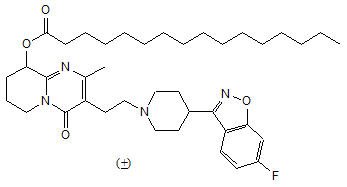
Paliperidone palmitate is very slightly soluble in ethanol and methanol, practically insoluble in polyethylene glycol 400 and propylene glycol, and slightly soluble in ethyl acetate.
INVEGA SUSTENNA is available as a white to off-white sterile aqueous extended-release suspension for intramuscular injection in the following dose strengths of paliperidone palmitate (and deliverable volumes) of the single-dose prefilled syringes: 39 mg (0.25 mL), 78 mg (0.5 mL), 117 mg (0.75 mL), 156 mg (1.0 mL), and 234 mg (1.5 mL). The drug product hydrolyzes to the active moiety, paliperidone, resulting in dose strengths of 25 mg, 50 mg, 75 mg, 100 mg, and 150 mg of paliperidone, respectively. The inactive ingredients are polysorbate 20 (12 mg/mL), polyethylene glycol 4000 (30 mg/mL), citric acid monohydrate (5 mg/mL), disodium hydrogen phosphate anhydrous (5 mg/mL), sodium dihydrogen phosphate monohydrate (2.5 mg/mL), sodium hydroxide (2.84 mg/mL used as an alkalizing agent to set pH at 7), and water for injection.
INVEGA SUSTENNA is provided in a single-dose prefilled syringe (cyclic-olefin-copolymer) with a plunger stopper and tip cap (bromobutyl rubber). The kit also contains 2 safety needles (a 1 ½-inch 22 gauge safety needle and a 1-inch 23 gauge safety needle).
12. Invega Sustenna - Clinical Pharmacology
12.1 Mechanism of Action
Paliperidone palmitate is hydrolyzed to paliperidone [see Clinical Pharmacology (12.3)] . Paliperidone is the major active metabolite of risperidone. The mechanism of action of paliperidone is unclear. However, the drug's therapeutic effect in schizophrenia could be mediated through a combination of central dopamine Type 2 (D 2) and serotonin Type 2 (5HT 2A) receptor antagonism.
12.2 Pharmacodynamics
In vitro, paliperidone acts as an antagonist at the central dopamine Type 2 (D 2) and serotonin Type 2 (5HT 2A) receptors with binding affinities (Ki values) of 1.6–2.8 nM for D 2and 0.8–1.2 nM for 5HT 2Areceptors. Paliperidone is also active as an antagonist at histamine H 1and α 1and α 2adrenergic receptors with binding affinities of 32 nM, 4 nM, 17 nM, respectively. Paliperidone has no affinity for cholinergic muscarinic or β 1- and β 2-adrenergic receptors. The pharmacological activity of the (+)- and (-)- paliperidone enantiomers is qualitatively and quantitatively similar .
12.3 Pharmacokinetics
Absorption and Distribution
Due to its extremely low water solubility, the 1-month formulation of paliperidone palmitate dissolves slowly after intramuscular injection before being hydrolyzed to paliperidone and absorbed into the systemic circulation. Following a single intramuscular dose, the plasma concentrations of paliperidone gradually rise to reach maximum plasma concentrations at a median T maxof 13 days. The release of the drug starts as early as day 1 and lasts for as long as 126 days.
Following intramuscular injection of single doses (39 mg – 234 mg) in the deltoid muscle, on average, a 28% higher C maxwas observed compared with injection in the gluteal muscle. The two initial deltoid intramuscular injections of 234 mg on day 1 and 156 mg on day 8 help attain therapeutic concentrations rapidly. The release profile and dosing regimen of INVEGA SUSTENNA results in sustained therapeutic concentrations. The AUC of paliperidone following INVEGA SUSTENNA administration was dose-proportional over a 39 mg-234 mg dose range, and less than dose-proportional for C maxfor doses exceeding 78 mg. The mean steady-state peak:trough ratio for an INVEGA SUSTENNA dose of 156 mg was 1.8 following gluteal administration and 2.2 following deltoid administration.
Following administration of paliperidone palmitate the (+) and (-) enantiomers of paliperidone interconvert, reaching an AUC (+) to (-) ratio of approximately 1.6–1.8.
Based on a population analysis, the apparent volume of distribution of paliperidone is 391 L. The plasma protein binding of racemic paliperidone is 74%.
Metabolism and Elimination
In a study with oral immediate-release 14C-paliperidone, one week following administration of a single oral dose of 1 mg immediate-release 14C-paliperidone, 59% of the dose was excreted unchanged into urine, indicating that paliperidone is not extensively metabolized in the liver. Approximately 80% of the administered radioactivity was recovered in urine and 11% in the feces. Four metabolic pathways have been identified in vivo, none of which accounted for more than 10% of the dose: dealkylation, hydroxylation, dehydrogenation, and benzisoxazole scission. Although in vitrostudies suggested a role for CYP2D6 and CYP3A4 in the metabolism of paliperidone, there is no evidence in vivothat these isozymes play a significant role in the metabolism of paliperidone. Population pharmacokinetics analyses indicated no discernible difference on the apparent clearance of paliperidone after administration of oral paliperidone between extensive metabolizers and poor metabolizers of CYP2D6 substrates.
The median apparent half-life of paliperidone following INVEGA SUSTENNA single-dose administration over the dose range of 39 mg – 234 mg ranged from 25 days – 49 days.
Long-Acting Paliperidone Palmitate Injection versus Oral Extended-Release Paliperidone
INVEGA SUSTENNA is designed to deliver paliperidone over a monthly period while extended-release oral paliperidone is administered on a daily basis. The initiation regimen for INVEGA SUSTENNA (234 mg/156 mg in the deltoid muscle on Day 1/Day 8) was designed to rapidly attain steady-state paliperidone concentrations when initiating therapy without the use of oral supplementation.
In general, overall initiation plasma levels with INVEGA SUSTENNA were within the exposure range observed with 6–12 mg extended-release oral paliperidone. The use of the INVEGA SUSTENNA initiation regimen allowed patients to stay in this exposure window of 6–12 mg extended-release oral paliperidone even on trough pre-dose days (Day 8 and Day 36). The intersubject variability for paliperidone pharmacokinetics following delivery from INVEGA SUSTENNA was lower relative to the variability determined from extended-release oral paliperidone tablets. Because of the difference in median pharmacokinetic profiles between the two products, caution should be exercised when making a direct comparison of their pharmacokinetic properties.
Drug Interaction Studies
No specific drug interaction studies have been performed with INVEGA SUSTENNA. The information below is obtained from studies with oral paliperidone.
Effects of other drugs on the exposures of paliperidone are summarized in Figure 1. After oral administration of 20 mg/day of paroxetine (a potent CYP2D6 inhibitor), an increase in mean C maxand AUC values at steady-state was observed (see Figure 1). Higher doses of paroxetine have not been studied. The clinical relevance is unknown. After oral administration, a decrease in mean C maxand AUC values at steady state is expected when patients are treated with carbamazepine, a strong inducer of both CYP3A4 and P-gp [see Drug Interactions (7.1)] . This decrease is caused, to a substantial degree, by a 35% increase in renal clearance of paliperidone.
Figure 1: The effects of other drugs on paliperidone pharmacokinetics.
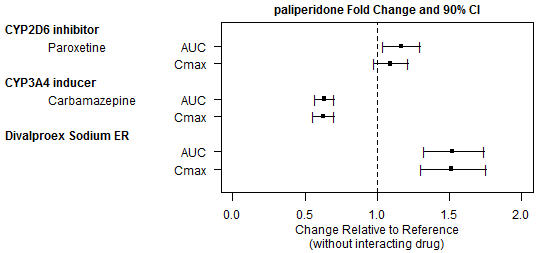
Clinically meaningful pharmacokinetic interaction between INVEGA SUSTENNA and valproate (including valproic acid and divalproex sodium) is not expected. Oral administration of divalproex sodium extended-release tablets (two 500 mg tablets once daily at steady-state) with oral paliperidone extended-release tablets resulted in an increase of approximately 50% in the C maxand AUC of paliperidone.
After oral administration of paliperidone, the steady-state C maxand AUC of divalproex sodium extended-release tablets were not affected in 13 patients stabilized on divalproex sodium extended-release tablets. In a clinical study, subjects on stable doses of divalproex sodium extended-release tablets had comparable valproate average plasma concentrations when oral paliperidone extended-release tablets 3–15 mg/day was added to their existing divalproex sodium extended-release tablets treatment [see Drug Interactions (7.2)] .
In vitrostudies indicate that CYP2D6 and CYP3A4 may be involved in paliperidone metabolism, however, there is no evidence in vivothat inhibitors of these enzymes significantly affect the metabolism of paliperidone; they contribute to only a small fraction of total body clearance. In vitrostudies demonstrated that paliperidone is a substrate of P-glycoprotein (P-gp) [see Drug Interactions (7.2)] .
In vitrostudies in human liver microsomes demonstrated that paliperidone does not substantially inhibit the metabolism of drugs metabolized by cytochrome P450 isozymes, including CYP1A2, CYP2A6, CYP2C8/9/10, CYP2D6, CYP2E1, CYP3A4, and CYP3A5. Therefore, paliperidone is not expected to inhibit clearance of drugs that are metabolized by these metabolic pathways in a clinically relevant manner. Paliperidone is also not expected to have enzyme inducing properties.
Paliperidone is a weak inhibitor of P-gp at high concentrations. No in vivodata are available, and the clinical relevance is unknown.
Studies in Specific Populations
No specific pharmacokinetic studies have been performed with INVEGA SUSTENNA in specific populations. All the information is obtained from studies with oral paliperidone or is based on the population pharmacokinetic modelling of oral paliperidone and INVEGA SUSTENNA. Exposures of paliperidone in specific populations (renal impairment, hepatic impairment and elderly) are summarized in Figure 2 [see Dosage and Administration (2.5)and Use in Specific Populations (8.6)] .
After oral administration of paliperidone in patients with moderate hepatic impairment, the plasma concentrations of free paliperidone were similar to those of healthy subjects, although total paliperidone exposure decreased because of a decrease in protein binding. Paliperidone has not been studied in patients with severe hepatic impairment [see Use in Specific Populations (8.7)] .
After oral administration of paliperidone in elderly subjects, the C maxand AUC increased 1.2-fold compared to young subjects. However, there may be age-related decreases in creatinine clearance [see Dosage and Administration (2.5)and Use in Specific Populations (8.5)] .
Figure 2: Effects of intrinsic factors on paliperidone pharmacokinetics.
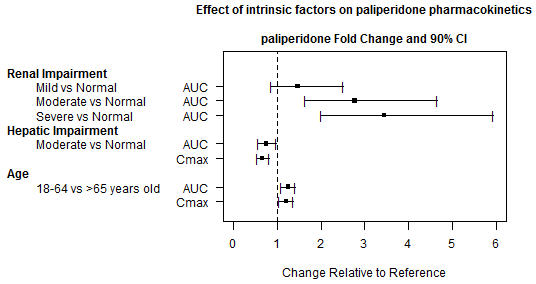
Based on in vitrostudies utilizing human liver enzymes, paliperidone is not a substrate for CYP1A2; smoking should, therefore, not have an effect on the pharmacokinetics of paliperidone.
Slower absorption was observed in females in a population pharmacokinetic analysis. At apparent steady-state with INVEGA SUSTENNA, the trough concentrations were similar between males and females.
Lower C maxwas observed in overweight and obese subjects. At apparent steady-state with INVEGA SUSTENNA, the trough concentrations were similar among normal, overweight, and obese subjects.
13. Nonclinical Toxicology
13.1 Carcinogenesis, Mutagenesis, Impairment of Fertility
Carcinogenesis
The carcinogenic potential of intramuscularly injected paliperidone palmitate was assessed in rats. There was an increase in mammary gland adenocarcinomas in female rats at 16, 47, and 94 mg/kg/month, which is 0.6, 2, and 4 times, respectively, the MRHD of 234 mg of INVEGA SUSTENNA based on mg/m 2body surface area. A no-effect dose was not established. Male rats showed an increase in mammary gland adenomas, fibroadenomas, and carcinomas at 2 and 4 times the MRHD based on mg/m 2body surface area. A carcinogenicity study in mice has not been conducted with paliperidone palmitate.
Carcinogenicity studies with risperidone, which is extensively converted to paliperidone in rats, mice, and humans, were conducted in Swiss albino mice and Wistar rats. Risperidone was administered in the diet at daily doses of 0.63, 2.5, and 10 mg/kg for 18 months to mice and for 25 months to rats. A maximum tolerated dose was not achieved in male mice. There were statistically significant increases in pituitary gland adenomas, endocrine pancreas adenomas, and mammary gland adenocarcinomas. The no-effect dose for these tumors was less than or equal to the maximum recommended human dose of risperidone based on mg/m 2body surface area (see risperidone package insert). An increase in mammary, pituitary, and endocrine pancreas neoplasms has been found in rodents after chronic administration of other antipsychotic drugs and is considered to be mediated by prolonged dopamine D 2antagonism and hyperprolactinemia. The relevance of these tumor findings in rodents to human risk is unclear [see Warnings and Precautions (5.7)] .
Mutagenesis
Paliperidone palmitate showed no genotoxicity in the in vitroAmes bacterial reverse mutation test or the mouse lymphoma assay. Paliperidone was not genotoxic in the in vitroAmes bacterial reverse mutation test, the mouse lymphoma assay, or the in vivorat bone marrow micronucleus test.
Impairment of Fertility
No fertility studies were conducted with paliperidone palmitate.
In an oral paliperidone study of fertility, the percentage of treated female rats that became pregnant was not affected at oral doses of paliperidone of up to 2.5 mg/kg/day which is 2 times the MRHD based on mg/m 2body surface area. However, pre- and post-implantation loss was increased, and the number of live embryos was slightly decreased, at 2.5 mg/kg, a dose that also caused slight maternal toxicity. These parameters were not affected at a dose of 0.63 mg/kg, which is half of the MRHD based on mg/m 2body surface area.
The fertility of male rats was not affected at oral doses of paliperidone of up to 2 times the MRHD of 12 mg/day based on mg/m 2body surface area, although sperm count and sperm viability studies were not conducted with paliperidone. In a subchronic study in Beagle dogs with risperidone, which is extensively converted to paliperidone in dogs and humans, all doses tested (0.31 mg/kg – 5.0 mg/kg) resulted in decreases in serum testosterone and in sperm motility and concentration (0.6 to 10 times the MRHD of 16 mg/day for risperidone, based on mg/m 2body surface area). Serum testosterone and sperm parameters partially recovered, but remained decreased after the last observation (two months after treatment was discontinued).
14. Clinical Studies
14.1 Schizophrenia
Short-Term Monotherapy (Studies 1, 2, 3, 4)
The efficacy of INVEGA SUSTENNA in the acute treatment of schizophrenia was evaluated in four short-term (one 9-week and three 13-week) double-blind, randomized, placebo-controlled, fixed-dose studies of acutely relapsed adult inpatients who met DSM-IV criteria for schizophrenia. The fixed doses of INVEGA SUSTENNA in these studies were given on days 1, 8, and 36 in the 9-week study, and additionally on day 64 of the 13-week studies, i.e., at a weekly interval for the initial two doses and then every 4 weeks for maintenance.
Efficacy was evaluated using the total score on the Positive and Negative Syndrome Scale (PANSS). The PANSS is a 30-item scale that measures positive symptoms of schizophrenia (7 items), negative symptoms of schizophrenia (7 items), and general psychopathology (16 items), each rated on a scale of 1 (absent) to 7 (extreme); total PANSS scores range from 30 to 210.
In Study 1 (PSY-3007), a 13-week study (n=636) comparing three fixed doses of INVEGA SUSTENNA (initial deltoid injection of 234 mg followed by 3 gluteal or deltoid doses of either 39 mg/4 weeks, 156 mg/4 weeks or 234 mg/4 weeks) to placebo, all three doses of INVEGA SUSTENNA were superior to placebo in improving the PANSS total score.
In Study 2 (PSY-3003), another 13-week study (n=349) comparing three fixed doses of INVEGA SUSTENNA (78 mg/4 weeks, 156 mg/4 weeks, and 234 mg/4 weeks) to placebo, only 156 mg/4 weeks of INVEGA SUSTENNA was superior to placebo in improving the PANSS total score.
In Study 3 (PSY-3004), a third 13-week study (n=513) comparing three fixed doses of INVEGA SUSTENNA (39 mg/4 weeks, 78 mg/4 weeks, and 156 mg/4 weeks) to placebo, all three doses of INVEGA SUSTENNA were superior to placebo in improving the PANSS total score.
In Study 4 (SCH-201), the 9-week study (n=197) comparing two fixed doses of INVEGA SUSTENNA (78 mg/4 weeks and 156 mg/4 weeks) to placebo, both doses of INVEGA SUSTENNA were superior to placebo in improving PANSS total score.
A summary of the mean baseline PANSS scores along with the mean changes from baseline in the four short-term acute schizophrenia studies are provided in Table 14.
| Study Number | Treatment Group | Primary Efficacy Measure: PANSS Total Score | ||
|---|---|---|---|---|
| Mean Baseline Score (SD) | LS Mean Change from Baseline (SE) | Placebo-subtracted Difference
*
(95% CI) |
||
| SD: standard deviation; SE: standard error; LS Mean: least-squares mean; CI: unadjusted confidence interval. | ||||
| Study 1 | INVEGA SUSTENNA (39 mg/4 weeks) † | 86.9 (11.99) | -11.2 (1.69) | -5.1 (-9.01, -1.10) |
| INVEGA SUSTENNA (156 mg/4 weeks) † | 86.2 (10.77) | -14.8 (1.68) | -8.7 (-12.62, -4.78) | |
| INVEGA SUSTENNA (234 mg/4 weeks) † | 88.4 (11.70) | -15.9 (1.70) | -9.8 (-13.71, -5.85) | |
| Placebo | 86.8 (10.31) | -6.1 (1.69) | -- | |
| Study 2‡ | INVEGA SUSTENNA (78 mg/4 weeks) | 89.9 (10.78) | -6.9 (2.50) | -3.5 (-8.73, 1.77) |
| INVEGA SUSTENNA (156 mg/4 weeks) † | 90.1 (11.66) | -10.4 (2.47) | -6.9 (-12.12, -1.68) | |
| Placebo | 92.4 (12.55) | -3.5 (2.15) | -- | |
| Study 3 | INVEGA SUSTENNA (39 mg/4 weeks) † | 90.7 (12.25) | -19.8 (2.19) | -6.6 (-11.40, -1.73) |
| INVEGA SUSTENNA (78 mg/4 weeks) † | 91.2 (12.02) | -19.2 (2.19) | -5.9 (-10.76, -1.07) | |
| INVEGA SUSTENNA (156 mg/4 weeks) † | 90.8 (11.70) | -22.5 (2.18) | -9.2 (-14.07, -4.43) | |
| Placebo | 90.7 (12.22) | -13.3 (2.21) | -- | |
| Study 4 | INVEGA SUSTENNA (78 mg/4 weeks) † | 88.0 (12.39) | -4.6 (2.43) | -11.2 (-16.85, -5.57) |
| INVEGA SUSTENNA (156 mg/4 weeks) † | 85.2 (11.09) | -7.4 (2.45) | -14.0 (-19.51, -8.58) | |
| Placebo | 87.8 (13.90) | 6.6 (2.45) | -- | |
Maintenance Monotherapy Treatment (Study 5: PSY-3001)
The efficacy of INVEGA SUSTENNA in maintaining symptomatic control in schizophrenia was established in a longer-term double-blind, placebo-controlled, flexible-dose study involving adult subjects who met DSM-IV criteria for schizophrenia. This study included a minimum 12-week, fixed-dose stabilization phase, and a randomized, placebo-controlled phase to observe for relapse. During the double-blind phase, patients were randomized to either the same dose of INVEGA SUSTENNA they received during the stabilization phase, i.e., 39 mg, 78 mg, or 156 mg administered every 4 weeks, or to placebo. A total of 410 stabilized patients were randomized to either INVEGA SUSTENNA or to placebo until they experienced a relapse of schizophrenia symptoms. Relapse was pre-defined as time to first emergence of one or more of the following: psychiatric hospitalization, ≥ 25% increase (if the baseline score was > 40) or a 10-point increase (if the baseline score was ≤ 40) in total PANSS score on two consecutive assessments, deliberate self-injury, violent behavior, suicidal/homicidal ideation, or a score of ≥ 5 (if the maximum baseline score was ≤ 3) or ≥ 6 (if the maximum baseline score was 4) on two consecutive assessments of the specific PANSS items. The primary efficacy variable was time to relapse. A pre-planned interim analysis showed a statistically significantly longer time to relapse in patients treated with INVEGA SUSTENNA compared to placebo, and the study was stopped early because maintenance of efficacy was demonstrated. Thirty-four percent (34%) of subjects in the placebo group and 10% of subjects in the INVEGA SUSTENNA group experienced a relapse event. There was a statistically significant difference between the treatment groups in favor of INVEGA SUSTENNA. A Kaplan-Meier plot of time to relapse by treatment group is shown in Figure 3. The time to relapse for subjects in the placebo group was statistically significantly shorter than for the INVEGA SUSTENNA group. An examination of population subgroups did not reveal any clinically significant differences in responsiveness on the basis of gender, age, or race.
Figure 3: Kaplan-Meier Plot of Cumulative Proportion of Subjects with Relapse Over Time (Schizophrenia Study 5)
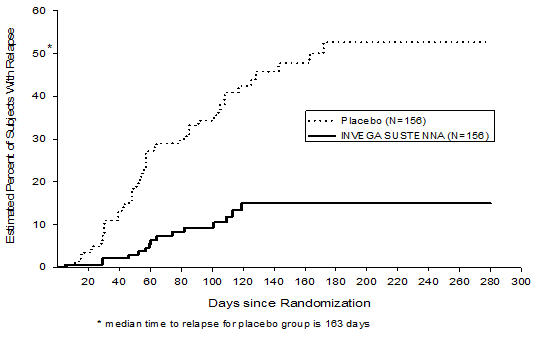
Long-Term Comparative Monotherapy Treatment versus Oral Antipsychotic Therapy (Study 6: SCH-3006)
The efficacy of INVEGA SUSTENNA in delaying time to treatment failure compared with selected oral antipsychotic medications was established in a long-term, randomized, flexible-dose study in subjects with schizophrenia and a history of incarceration. Subjects were screened for up to 14 days followed by a 15-month treatment phase during which they were observed for treatment failure.
The primary endpoint was time to first treatment failure. Treatment failure was defined as one of the following: arrest and/or incarceration; psychiatric hospitalization; discontinuation of antipsychotic treatment because of safety or tolerability; treatment supplementation with another antipsychotic because of inadequate efficacy; need for increase in level of psychiatric services to prevent an imminent psychiatric hospitalization; discontinuation of antipsychotic treatment because of inadequate efficacy; or suicide. Treatment failure was determined by an Event Monitoring Board (EMB) that was blinded to treatment assignment. A total of 444 subjects were randomly assigned to either INVEGA SUSTENNA (N = 226; median dose 156 mg) or one of up to seven pre-specified, flexibly-dosed, commonly prescribed oral antipsychotic medications (N = 218; aripiprazole, haloperidol, olanzapine, paliperidone, perphenazine, quetiapine, or risperidone). The selection of the oral antipsychotic medication was determined to be appropriate for the patient by the investigator. A statistically significantly longer time to first treatment failure was seen for INVEGA SUSTENNA compared with oral antipsychotic medications. The median time to treatment failure was 416 days and 226 days for INVEGA SUSTENNA and antipsychotic medications, respectively. A Kaplan-Meier plot of time to first treatment failure is shown in Figure 4. The frequencies of first treatment failure events by type are shown in Table 15. The time to first arrest and/or incarceration or psychiatric hospitalization was also statistically significantly longer for the INVEGA SUSTENNA group compared to the oral antipsychotic group.
Figure 4: Kaplan-Meier Plot of Time to First Treatment Failure in a Long-Term, Randomized, Flexible-Dose Study in Subjects with Schizophrenia and a History of Incarceration (Schizophrenia Study 6)
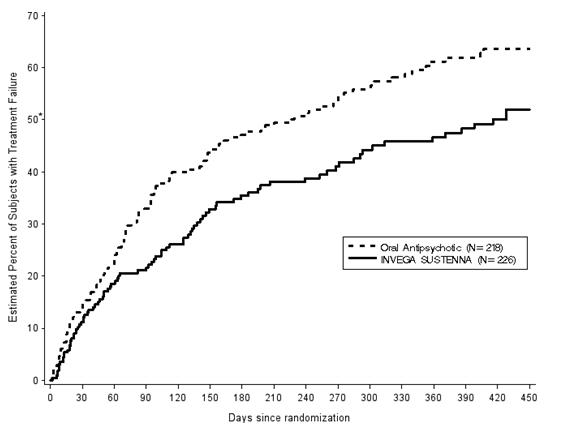
*Median time to first treatment failure: 416 days with INVEGA SUSTENNA; 226 days with oral antipsychotics
| Event Type | INVEGA SUSTENNA
N=226 frequency (%) | Oral Antipsychotics
N=218 frequency (%) | Hazard Ratio
*
[95% CI] |
|---|---|---|---|
|
|||
| First Treatment Failures | 90 (39.8%) | 117 (53.7%) | 0.70
[0.53, 0.92] |
| First Treatment Failure Component Events | |||
| 48 (21.2%) | 64 (29.4%) | |
| 18 (8.0%) | 26 (11.9%) | |
| 15 (6.6%) | 8 (3.7%) | |
| 5 (2.2%) | 6 (2.8%) | |
| 3 (1.3%) | 4 (1.8%) | |
| 1 (0.4%) | 9 (4.1%) | |
| 0 | 0 | |
| Arrest and/or Incarceration or Psychiatric Hospitalization Events, regardless of whether they were first events† | 76 (33.6%) | 98 (45.0%) | 0.70
[0.52, 0.94] |
14.2 Schizoaffective Disorder
Maintenance Treatment – Monotherapy and as Adjunct to Mood Stabilizer or Antidepressant (SAff Study 1: SCA-3004)
The efficacy of INVEGA SUSTENNA in maintaining symptom control in schizoaffective disorder was established in a long-term double-blind, placebo-controlled, flexible-dose randomized-withdrawal study designed to delay relapse in adult subjects who met DSM-IV criteria for schizoaffective disorder, as confirmed by the Structured Clinical Interview for DSM-IV Disorders. The population included subjects with schizoaffective bipolar and depressive types. Subjects received INVEGA SUSTENNA either as monotherapy or as an adjunct to stable doses of antidepressant or mood stabilizers.
This study included a 13-week, open-label, flexible-dose (INVEGA SUSTENNA 78 mg, 117 mg, 156 mg, or 234 mg) lead-in period which enrolled a total of 667 subjects who had 1) acute exacerbation of psychotic symptoms; 2) score ≥4 on ≥3 PANSS items of delusions, conceptual disorganization, hallucinatory behavior, excitement, suspiciousness/persecution, hostility, uncooperativeness, tension, and poor impulse control; and 3) prominent mood symptoms ≥16 on the Young Mania Rating Scale (YMRS) and/or the Hamilton Rating Scale for Depression, 21-item version (HAM-D-21). Subjects were 19 to 66 years old (mean 39.5 years) and 53.5% were male. The mean scores at open-label enrollment of PANSS total was 85.8 (range 42 to 128), HAM-D-21 was 20.4 (range 3 to 43), YMRS was 18.6 (range 0 to 50), and CGI-S-SCA was 4.4 (range 2 to 6).
After the 13-week open-label flexible-dose INVEGA SUSTENNA treatment, 432 subjects met stabilization criteria (PANSS total score ≤70, YMRS ≤12, and HAM-D-21 ≤12) and continued into the 12-week open-label fixed-dose stabilization period.
A total of 334 subjects who met stabilization criteria for 12 consecutive weeks were randomized (1:1) to continue the same dose of INVEGA SUSTENNA or to placebo in the 15-month, double-blind, maintenance period. For the 164 subjects who were randomized to INVEGA SUSTENNA, dose distribution was 78 mg (4.9%), 117 mg (9.8%), 156 mg (47.0%), and 234 mg (38.4%). The primary efficacy variable was time to relapse. Relapse was defined as the first occurrence of one or more of the following: 1) psychiatric hospitalization; 2) intervention employed to avert hospitalization; 3) clinically significant self-injury, suicidal or homicidal ideation or violent behavior; 4) a score of ≥6 (if the score was ≤4 at randomization) of any of the individual PANSS items: delusions, conceptual disorganization, hallucinatory behavior, excitement, suspiciousness/persecution, hostility, uncooperativeness, or poor impulse control; 5) on two consecutive assessments within 7 days: ≥25% increase (if the score at randomization was >45) or ≥10-point increase (if the score at randomization was ≤45) in total PANSS score; a score of ≥5 (if the score was ≤3 at randomization) of any of the individual PANSS items: delusions, conceptual disorganization, hallucinatory behavior, excitement, suspiciousness/persecution, hostility, uncooperativeness, or poor impulse control; an increase of ≥2 points (if the score was 1 [not ill] to 3 [mildly ill] at randomization) or increase of ≥1 point (if the score was ≥4 [moderately ill or worse] at randomization) in CGI-S-SCA overall score.
There was a statistically significant difference in time to relapse between the treatment groups in favor of INVEGA SUSTENNA. A Kaplan-Meier plot of time to relapse by treatment group is shown in Figure 5.
Figure 5: Kaplan-Meier Plot of Cumulative Proportion of Subjects with Relapse Over Time (SAff Study 1)
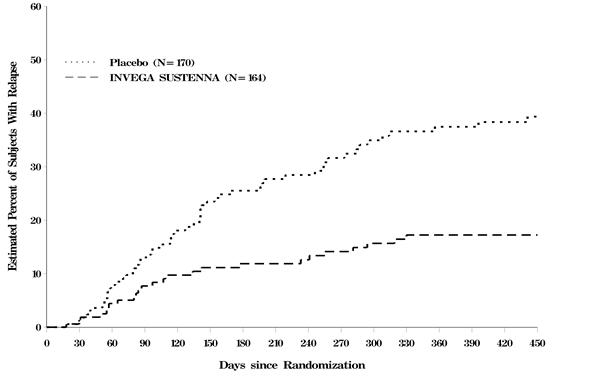
Table 16 summarizes the number of subjects with relapse in the overall population, by subgroup (monotherapy vs. adjunctive therapy), and by symptom type at the first occurrence of relapse.
| Number (Percent) of Subjects Who Relapsed | ||
|---|---|---|
| Placebo
N=170 | INVEGA SUSTENNA
N=164 |
|
| All Subjects | 57 (33.5%) | 25 (15.2%) |
| Monotherapy subset | N=73
24 (32.9%) | N=78
9 (11.5%) |
| Adjunct to Antidepressants or Mood Stabilizer subset | N=97
33 (34.0%) | N=86
16 (18.6%) |
| Psychotic Symptoms* | 53 (31.2%) | 21 (12.8%) |
| Mood Symptoms† | ||
| Any Mood Symptoms | 48 (28.2%) | 18 (11.0%) |
| Manic | 16 (9.4%) | 5 (3.0%) |
| Depressive | 23 (13.5%) | 8 (4.9%) |
| Mixed | 9 (5.3%) | 5 (3.0%) |
16. How is Invega Sustenna supplied
INVEGA SUSTENNA ®is available as a white to off-white sterile aqueous extended-release suspension for intramuscular injection in dose strengths of 39 mg/0.25 mL, 78 mg/0.5 mL, 117 mg/0.75 mL, 156 mg/mL, and 234 mg/1.5 mL paliperidone palmitate in single-dose prefilled syringes. The single-use kit contains a prefilled syringe and 2 safety needles (a 1 ½-inch 22 gauge safety needle and a 1-inch 23 gauge safety needle).
| 39 mg paliperidone palmitate kit | (NDC 50458-560-01) |
| 78 mg paliperidone palmitate kit | (NDC 50458-561-01) |
| 117 mg paliperidone palmitate kit | (NDC 50458-562-01) |
| 156 mg paliperidone palmitate kit | (NDC 50458-563-01) |
| 234 mg paliperidone palmitate kit | (NDC 50458-564-01) |
17. Patient Counseling Information
Advise the patient to read the FDA-approved patient labeling (Patient Information).
Neuroleptic Malignant Syndrome (NMS)
Counsel patients about a potentially fatal adverse reaction, Neuroleptic Malignant Syndrome (NMS), that has been reported in association with administration of antipsychotic drugs. Advise patients, family members, or caregivers to contact their healthcare provider or report to the emergency room if they experience signs and symptoms of NMS, including hyperpyrexia, muscle rigidity, altered mental status including delirium, and evidence of autonomic instability (irregular pulse or blood pressure, tachycardia, diaphoresis, and cardiac dysrhythmia) [see Warnings and Precautions (5.3)].
Tardive Dyskinesia
Counsel patients on the signs and symptoms of tardive dyskinesia and to contact their healthcare provider if these abnormal movements occur [see Warnings and Precautions (5.5)].
Metabolic Changes
Educate patients about the risk of metabolic changes, how to recognize symptoms of hyperglycemia and diabetes mellitus, and the need for specific monitoring, including blood glucose, lipids, and weight [see Warnings and Precautions (5.6)].
Orthostatic Hypotension
Educate patients about the risk of orthostatic hypotension and syncope, particularly at the time of initiating treatment, re-initiating treatment, or increasing the dose [see Warnings and Precautions (5.7)] .
Leukopenia/Neutropenia
Advise patients with a pre-existing low WBC or a history of drug-induced leukopenia/neutropenia that they should have their CBC monitored while taking INVEGA SUSTENNA [see Warnings and Precautions (5.9)] .
Hyperprolactinemia
Counsel patients on signs and symptoms of hyperprolactinemia that may be associated with chronic use of INVEGA SUSTENNA. Advise them to seek medical attention if they experience any of the following: amenorrhea or galactorrhea in females, erectile dysfunction or gynecomastia in males [see Warnings and Precautions (5.10)] .
Interference with Cognitive and Motor Performance
Caution patients about performing activities requiring mental alertness, such as operating hazardous machinery or operating a motor vehicle, until they are reasonably certain that INVEGA SUSTENNA therapy does not affect them adversely [see Warnings and Precautions (5.11)] .
Priapism
Advise patients of the possibility of painful or prolonged penile erections (priapism). Instruct the patient to seek immediate medical attention in the event of priapism [see Warnings and Precautions (5.14)] .
Heat Exposure and Dehydration
Counsel patients regarding appropriate care in avoiding overheating and dehydration [see Warnings and Precautions (5.15)] .
Concomitant Medication
Advise patients to inform their healthcare providers if they are taking, or plan to take any prescription or over-the-counter medications because there is a potential for clinically significant interactions [see Drug Interactions (7)] .
Alcohol
Advise patients to avoid alcohol during treatment with INVEGA SUSTENNA [see Drug Interactions (7.1)] .
Pregnancy
Advise patients to notify their healthcare provider if they become pregnant or intend to become pregnant during treatment with INVEGA SUSTENNA. Advise patients that INVEGA SUSTENNA may cause extrapyramidal and/or withdrawal symptoms in a neonate. Advise patients that there is a pregnancy registry that monitors pregnancy outcomes in women exposed to INVEGA SUSTENNA during pregnancy [see Use in Specific Populations (8.1)] .
Lactation
Advise breastfeeding women using INVEGA SUSTENNA to monitor infants for somnolence, failure to thrive, jitteriness, and extrapyramidal symptoms (tremors and abnormal muscle movements) and to seek medical care if they notice these signs [see Use in Specific Populations (8.2)] .
Infertility
Advise females of reproductive potential that INVEGA SUSTENNA may impair fertility due to an increase in serum prolactin levels. The effects on fertility are reversible [see Use in Specific Populations (8.3)].
INVEGA SUSTENNA (paliperidone palmitate) Extended-Release Injectable Suspension
Product of Ireland
Manufactured by:
Janssen Pharmaceutica NV
Beerse, Belgium
Manufactured for:
Janssen Pharmaceuticals, Inc.
Titusville, NJ 08560, USA
For patent information: www.janssenpatents.com
©2009 Janssen Pharmaceutical Companies
| This Patient Information has been approved by the U.S. Food and Drug Administration. Revised: September 2024 | |
|
PATIENT INFORMATION
|
|
|
What is the most important information I should know about INVEGA SUSTENNA? INVEGA SUSTENNA can cause serious side effects, including:
|
|
|
What is INVEGA SUSTENNA? INVEGA SUSTENNA is a prescription medicine given by injection by a healthcare professional and used to treat: |
|
|
|
|
It is not known if INVEGA SUSTENNA is safe and effective in children under 18 years of age. |
|
|
Who should not receive INVEGA SUSTENNA? Do not receive INVEGA SUSTENNA if you:
|
|
|
What should I tell my healthcare provider before receiving INVEGA SUSTENNA? Before you receive INVEGA SUSTENNA, tell your healthcare provider about all your medical conditions, including if you:
Tell your healthcare provider about all the medicines you take, including prescription and over-the-counter medicines, vitamins, and herbal supplements. Know the medicines you take. Keep a list of them to show to your healthcare provider or pharmacist when you get a new medicine. |
|
|
How will I receive INVEGA SUSTENNA?
|
|
|
What should I avoid while receiving INVEGA SUSTENNA?
|
|
|
What are the possible side effects of INVEGA SUSTENNA? INVEGA SUSTENNA may cause serious side effects, including:
|
|
|
The most common side effects of INVEGA SUSTENNA include:injection site reactions, sleepiness or drowsiness, dizziness, feeling restlessness or needing to be constantly moving, abnormal muscle movements including tremor (shaking), shuffling, uncontrolled involuntary movements, and abnormal movements of your eyes. Tell your healthcare provider if you have any side effect that bothers you or does not go away. These are not all the possible side effects of INVEGA SUSTENNA. For more information, ask your healthcare provider or pharmacist. Call your doctor for medical advice about side effects. You may report side effects to FDA at 1-800-FDA-1088. |
|
|
General information about the safe and effective use of INVEGA SUSTENNA. Medicines are sometimes prescribed for purposes other than those listed in a Patient Information leaflet. Do not use INVEGA SUSTENNA for a condition for which it was not prescribed. Do not give INVEGA SUSTENNA to other people, even if they have the same symptoms that you have. It may harm them. You can ask your pharmacist or healthcare provider for information about INVEGA SUSTENNA that is written for healthcare professionals. This Patient Information leaflet summarizes the most important information about INVEGA SUSTENNA. If you would like more information, talk with your healthcare provider. You can ask your healthcare provider or pharmacist for more information that is written for healthcare professionals. For more information, go to www.invegasustenna.com or call 1-800-526-7736. |
|
|
What are the ingredients in INVEGA SUSTENNA? Active ingredient: paliperidone palmitate Inactive ingredients:polysorbate 20, polyethylene glycol 4000, citric acid monohydrate, sodium dihydrogen phosphate monohydrate, sodium hydroxide, and water for injection Manufactured by: Janssen Pharmaceutica NV, Beerse, Belgium
|
|
INSTRUCTIONS FOR USE
INVEGA SUSTENNA ®
(paliperidone palmitate)
extended-release injectable suspension
Rx only
Single use only
PLEASE READ COMPLETE INSTRUCTIONS PRIOR TO USE
For deltoid and gluteal intramuscular injection only
Please see accompanying full Package Insert.
IMPORTANT RESOURCES
For additional information, visit www.invegasustenna.comor call Janssen Pharmaceuticals, Inc. at 1-800-526-7736.
Kit contents
Each injection must be administered only by a health care professional. The kit contains a prefilled syringe and 2 safety needles (a 1 ½-inch 22 gauge needle and a 1-inch 23 gauge needle) for intramuscular injection. INVEGA SUSTENNA is for single use only.
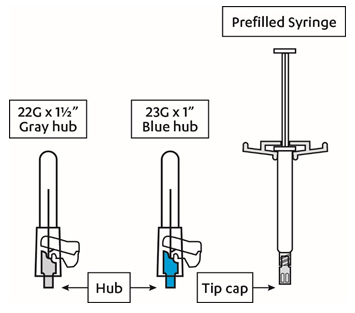
INVEGA SUSTENNA is intended for intramuscular use only. Inject slowly, deep into the muscle. Care should be taken to avoid inadvertent injection into a blood vessel. Each injection should be administered by a health care professional. Administration should be in a single injection. Do not administer the dose in divided injections. Do not administer intravascularly or subcutaneously.
INSTRUCTIONS FOR USE
- Shake the syringe vigorously for a minimum of 10 seconds to ensure a homogeneous suspension.
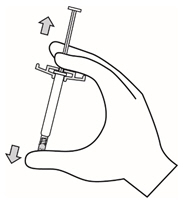
- Select the appropriate needle.
For DELTOID injection:- If the patient weighs less than 90 kg, use the 1-inch 23gauge needle (needle with bluecolored hub).
- If the patient weighs 90 kg or more, use the 1 ½-inch 22gauge needle (needle with graycolored hub).
Use the 1 ½-inch 22gauge needle (needle with graycolored hub) regardless of patient's weight. - Hold the syringe with the tip cap pointing up. Remove the rubber tip cap with a gentle twisting motion.
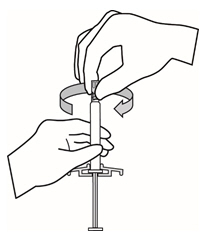
- Peel the safety needle pouch half way open. Grasp the needle sheath using the plastic peel pouch. Hold the syringe pointing up. Attach the safety needle to the syringe using a gentle twisting motion to avoid needle hub cracks or damage. Always check for signs of damage or leaking prior to administration.
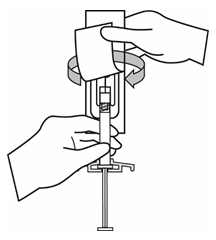
- Pull the needle sheath away from the needle with a straight pull. Do not twist the sheath as the needle may be loosened from the syringe.
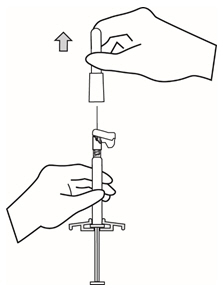
- Bring the syringe with the attached needle in upright position to de-aerate. De-aerate the syringe by moving the plunger rod carefully forward.
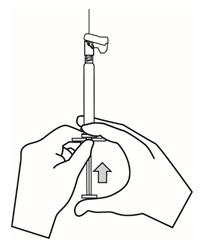
- Inject the entire contents intramuscularly slowly, deep into the selected deltoid or gluteal muscle of the patient. Do not administer by any other route.
- After the injection is complete, use either thumb or finger of one hand (h1, h2) or a flat surface (h3) to activate the needle protection system. The needle protection system is fully activated when a 'click' is heard. Discard the syringe with needle appropriately.
Keep out of reach of children.
| h1 | |
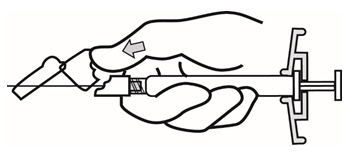 |
|
| h2 | |
 |
|
| h3 | |
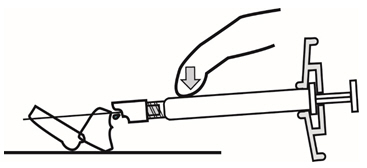 |
|
Manufactured for:
Janssen Pharmaceuticals, Inc.
Titusville, NJ 08560
For patent information: www.janssenpatents.com
©2009 Janssen Pharmaceutical Companies
This Instructions for Use has been approved by the U.S. Food and Drug Administration.
Revised: 9/2024
PRINCIPAL DISPLAY PANEL - 39 mg Syringe Kit
NDC 50458-560-01
Rx only
Single-dose prefilled syringe. Use entire contents of syringe.
INVEGA SUSTENNA ®
(paliperidone palmitate)
extended-release injectable suspension
39 mg/0.25 mL
39 mg/0.25 mL
Each single-dose prefilled syringe contains
39 mg (0.25 mL) paliperidone palmitate.
FOR INTRAMUSCULAR INJECTION ONLY
Shake before using
Each injection must be administered only by a healthcare professional.
CONTENTS: 1 single-dose prefilled syringe and 2 needles
(a 22G, 1½-inch safety needle and a 23G, 1-inch safety needle)
Store at room temperature (77°F, 25°C);
excursions between 59°F and 86°F (15°C and 30°C) are permitted.
For initiation and monthly maintenance dosing
instructions, please see accompanying full
Package Insert.
janssen

PRINCIPAL DISPLAY PANEL - 78 mg Syringe Kit
NDC 50458-561-01
Rx only
Single-dose prefilled syringe. Use entire contents of syringe.
INVEGA SUSTENNA ®
(paliperidone palmitate)
extended-release injectable suspension
78 mg/0.5 mL
78 mg/0.5 mL
Each single-dose prefilled syringe contains
78 mg (0.5 mL) paliperidone palmitate.
FOR INTRAMUSCULAR INJECTION ONLY
Shake before using
Each injection must be administered only by a healthcare professional.
CONTENTS: 1 single-dose prefilled syringe and 2 needles
(a 22G, 1½-inch safety needle and a 23G, 1-inch safety needle)
Store at room temperature (77°F, 25°C);
excursions between 59°F and 86°F (15°C and 30°C) are permitted.
For initiation and monthly maintenance dosing
instructions, please see accompanying full
Package Insert.
janssen

PRINCIPAL DISPLAY PANEL - 117 mg Syringe Kit
NDC 50458-562-01
Rx only
Single-dose prefilled syringe. Use entire contents of syringe.
INVEGA SUSTENNA ®
(paliperidone palmitate)
extended-release injectable suspension
117 mg/0.75 mL
117 mg/0.75 mL
Each single-dose prefilled syringe contains
117 mg (0.75 mL) paliperidone palmitate.
FOR INTRAMUSCULAR INJECTION ONLY
Shake before using
Each injection must be administered only by a healthcare professional.
CONTENTS: 1 single-dose prefilled syringe and 2 needles
(a 22G, 1½-inch safety needle and a 23G, 1-inch safety needle)
Store at room temperature (77°F, 25°C);
excursions between 59°F and 86°F (15°C and 30°C) are permitted.
For initiation and monthly maintenance dosing
instructions, please see accompanying full
Package Insert.
janssen

PRINCIPAL DISPLAY PANEL - 156 mg Syringe Kit
NDC 50458-563-01
Rx only
Single-dose prefilled syringe. Use entire contents of syringe.
INVEGA SUSTENNA ®
(paliperidone palmitate)
extended-release injectable suspension
156 mg/mL
156 mg/mL
Each single-dose prefilled syringe contains
156 mg (1 mL) paliperidone palmitate.
FOR INTRAMUSCULAR INJECTION ONLY
Shake before using
Each injection must be administered only by a healthcare professional.
CONTENTS: 1 single-dose prefilled syringe and 2 needles
(a 22G, 1½-inch safety needle and a 23G, 1-inch safety needle)
Store at room temperature (77°F, 25°C);
excursions between 59°F and 86°F (15°C and 30°C) are permitted.
For initiation and monthly maintenance dosing
instructions, please see accompanying full
Package Insert.
janssen

PRINCIPAL DISPLAY PANEL - 234 mg Syringe Kit
NDC 50458-564-01
Rx only
Single-dose prefilled syringe. Use entire contents of syringe.
INVEGA SUSTENNA ®
(paliperidone palmitate)
extended-release injectable suspension
234 mg/1.5 mL
234 mg/1.5 mL
Each single-dose prefilled syringe contains
234 mg (1.5 mL) paliperidone palmitate.
FOR INTRAMUSCULAR INJECTION ONLY
Shake before using
Each injection must be administered only by a healthcare professional.
CONTENTS: 1 single-dose prefilled syringe and 2 needles
(a 22G, 1½-inch safety needle and a 23G, 1-inch safety needle)
Store at room temperature (77°F, 25°C);
excursions between 59°F and 86°F (15°C and 30°C) are permitted.
For initiation and monthly maintenance dosing
instructions, please see accompanying full
Package Insert.
janssen

| INVEGA SUSTENNA
paliperidone palmitate injection |
||||||||||||||||||||
|
||||||||||||||||||||
|
||||||||||||||||||||
|
||||||||||||||||||||
|
||||||||||||||||||||
|
||||||||||||||||||||
| INVEGA SUSTENNA
paliperidone palmitate injection |
||||||||||||||||||||
|
||||||||||||||||||||
|
||||||||||||||||||||
|
||||||||||||||||||||
|
||||||||||||||||||||
|
||||||||||||||||||||
| INVEGA SUSTENNA
paliperidone palmitate injection |
||||||||||||||||||||
|
||||||||||||||||||||
|
||||||||||||||||||||
|
||||||||||||||||||||
|
||||||||||||||||||||
|
||||||||||||||||||||
| INVEGA SUSTENNA
paliperidone palmitate injection |
||||||||||||||||||||||||||||||
|
||||||||||||||||||||||||||||||
|
||||||||||||||||||||||||||||||
|
||||||||||||||||||||||||||||||
|
||||||||||||||||||||||||||||||
|
||||||||||||||||||||||||||||||
| INVEGA SUSTENNA
paliperidone palmitate injection |
||||||||||||||||||||||||||||||
|
||||||||||||||||||||||||||||||
|
||||||||||||||||||||||||||||||
|
||||||||||||||||||||||||||||||
|
||||||||||||||||||||||||||||||
|
||||||||||||||||||||||||||||||
| Labeler - Janssen Pharmaceuticals, Inc. (063137772) |
| Establishment | |||
| Name | Address | ID/FEI | Business Operations |
|---|---|---|---|
| Janssen Pharmaceutical Sciences Unlimited Company | 985639841 | api manufacture(50458-560, 50458-561, 50458-562, 50458-563, 50458-564) | |
| Establishment | |||
| Name | Address | ID/FEI | Business Operations |
|---|---|---|---|
| Janssen Pharmaceutica, NV | 370005019 | manufacture(50458-560, 50458-561, 50458-562, 50458-563, 50458-564) , analysis(50458-560, 50458-561, 50458-562, 50458-563, 50458-564) | |
Frequently asked questions
- How long does Invega Sustenna take to work?
- Can you drink alcohol while taking Invega Sustenna?
- Invega Sustenna vs Invega Trinza vs Invega Hafyera. What's the difference?
- How to transition to Invega Trinza from Invega Sustenna ?
- Does Invega Sustenna need to be refrigerated?
- How do you give an Invega Sustenna injection?
- How to transition to Invega Hayfera from Invega Trinza or Invega Sustenna?
More about Invega Sustenna (paliperidone)
- Check interactions
- Compare alternatives
- Pricing & coupons
- Reviews (193)
- Side effects
- Dosage information
- Patient tips
- During pregnancy
- Generic availability
- Support group
- FDA approval history
- Drug class: atypical antipsychotics
- Breastfeeding
- En español
Patient resources
Professional resources
Other brands
Invega Trinza, Invega Hafyera, Erzofri
